#higher expectations for their japanese media
Explore tagged Tumblr posts
Text
anyways top two tips for finding media with well written female characters! 1) consume media written by women and 2) stop consuming things written for adolescent boys!!!!
#talk tag#‘women just aren’t written well’ says mha pfp GET OUT OF HERE#honestly the second you stop watching shitty anime made for little boys the amount of well written women is overwhelming#sorry you have the media taste of a teenager but the adults are talking#not to be too mean it gets to me sometimes#but honestly even if you exclusively watch shounen anime (why?) it isn’t like there isn’t anything that writes women well#tpn and csm instantly come to mind#both manga that were/are massively popular during their runs in wsj#csm is up and down but the depth with which fujimoto writes female characters still astounds me#asa you are so special to me#but this is to say i still think that people need to make branch out more and maybe start having like#higher expectations for their japanese media#if they want to keep on consuming manga and anime#but seriously at some point i’m just going to assume you’re misogynistic no matter what if you refuse to look at female characters ever#people assume depth for male characters when there isn’t any and call every female character bland
61 notes
·
View notes
Note
Hi, I wasn't that anon but I have a PhD in music history and these responses to that Spotify post (much as I don't understand why that was sent to you) are hurting me. All I'm going to say is that if you're responding with "why is it always black people?" please take a history of popular music class if you genuinely do not understand why it is black people who get the focus when it comes to POPULAR MUSIC. (to be clear, this in this sense does not mean just "pop," but any genre that is not classical music or traditional folk music - so, rock, country, metal, R&B, hip hop, jazz all fall here, too)
Anon's whole point was that this is not a typical "minority representation" discussion, but one where the minority in question has always been dominant in this particular art form, in these particular genres, including being the majority in some of the ones Tumblr as a whole (maybe not the readership here specifically) really likes. You can't just import what you'd say about representation in any other medium. "Great black popular music artists" is not like, say, "great black filmmakers," it's more like "great female romance novelists." I don't even have to go out of my way to include black artists when I teach about American or British popular music, the way I do somewhat when I'm teaching about classical music. Yes, even from eras where the US popular music industry did their best to segregate them - you still had black artists who were influential and popular enough that they had lots of white audiences. Louis Armstrong and Nat King Cole come to mind.
I agree that just looking at people's Spotify Wrapped is not the greatest metric - as you said, what if someone was just listening to songs on there by a few artists. I use my Spotify mostly for playlists for my college classes I teach, so this particular year I was teaching a lot of Japanese popular music courses, and so they ended up being disproportionately Japanese. (I still had some black artists I was listening to in other contexts, though.) So my results tend to be odd and not very representative of their point. But I think I agree with the general point of why Black Tumblr users do this. Regardless, when people are responding to this with the same old discourse they use for every other discussion like this with something where black people (or whichever group) are UNDERrepresented, then they need to know that they missed the central point.
--
I get it, but truly, the number of weird nerds who don't listen to popular music from the Anglophone world in any kind of normal pattern is really, really high, and the amount that people get attacked even when it doesn't make sense is also very high. I know you and others are like "Well, we weren't talking about you", but when it comes to getting yelled at, they're quite right in thinking it is about them. That is how this nonsense always plays out, and it isn't necessarily black users spearheading it either.
This is US centrism wank boiling over, among other factors. The number of fans from outside the anglophone world coming at fandom from an all Asian media all the time place was high on my tumblr even during the years when I was completely out of Asian media fandoms. Now that I'm back in an Asian media phase, it's even higher. And that's just one cultural group that's going to be pissed about this kind of topic.
A couple of people have made stupidass comments, including about rap (quelle surprise), but the anger at being expected to know or care who Kendrick Lamar et al. are is not surprising.
Nobody should be looking at spotify wrapped this way in the first place.
In fact, nobody should be looking at spotify wrapped this year at all.
The real conversation should be about firing programmers and replacing them with incompetent AI.
60 notes
·
View notes
Text
Castle Solutions was the only time travel company in the world. They had a giant corporate headquarters in downtown Chicago, which was the only place in the entire world with a time machine, at least as far as anyone knew. They were worth hundreds of billions, and the only reason they weren't worth more seemed to be that they didn't care all that much about money. The time machines were used for everything: reporting, media, market corrections, the surveillance state, and industry. Castle Solutions was the lynchpin of the modern world.
Daniel had thought the waiting room would be nicer.
He sat in a blue-gray chair that would have been at home in any waiting room anywhere else in Chicago. Slightly tinny music played over speakers from the ceiling. A fake potted plant sat in one corner, failing to look lively. There were no windows, because the waiting room was deep in the heart of the building, close to the machine itself.
Daniel was the only one in the waiting room. He'd come half an hour early, lugging all his gear, and now the only thing left was for the clock to run down. A bored-looking woman had come in to tell him that it might be awhile, that they were running behind schedule — the time travel company, running behind schedule. So there had been more waiting than expected.
A man in a charcoal gray suit with a simple blue backpack came in. He slung the backpack down onto the ground with a sigh and rubbed his face. He had stubble there, but an artful amount of it, like he'd spent some time in the mirror making sure that it was the right amount of scruff to offset his expensive suit.
Daniel looked straight ahead, trying not to look, keeping his face blank, like he was passing by a homeless person who might ask him for money he didn't have.
"Wow, you've got a lot of stuff," said the man. "Is that a sword?"
"It's a katana," said Daniel. He didn't match the eye contact the man was giving him.
"Oh, cool," said the man. "You're going to ... katana times?"
"Edo Japan, yeah," said Daniel.
Daniel was trying his best not to engage, to get this conversation over as quickly as possible. He wasn't making eye contact.
The man picked up his backpack and moved across the waiting room to be closer to Daniel.
"You speak Japanese?" the man asked.
"Hai, watashi wa nihongo o hanashimasu," replied Daniel. He wished that he were more fluent, that the words had come out less rote.
"Cool," said the man. He had apparently also come closer to get a look at all of Daniel's stuff. His eyes moved over the duffel bags. There wasn't much to see, everything had been carefully packed away. "Wow, you sure are prepared, huh?"
"It's a different time and place," said Daniel with a shrug. It represented five years of planning, five years of training, learning, honing himself.
"Personally, I'm going to 1946," said the man, though Daniel hadn't asked. He held out his hand. "Archie Vedder."
Daniel reluctantly took the hand. "Daniel Strom." He had never really gotten the hang of shaking hands. He worried that his hands were too clammy, a worry that proved founded when Archie wiped his hand on that expensive charcoal suit.
"I went with the kit," said Archie, pointing to his backpack. "I've got papers, I've got a computer with a backup, I've got a projector, a media library, a science library, the whole works, plus some forged bonds and a stack of cash. I got a sweet deal on it, they're overstocked now."
Retreating into the past had seen its heyday. Now most of the people who had been most enthusiastic were gone, and there were only the dissenters left. Everyone agreed with using the machine for the mundane stuff, but simply leaving, never to return, rubbed people the wrong way.
"I guess they don't sell kits for Edo," Archie ventured.
"They do," said Daniel. "They're trash."
"Ah," said Archie.
"This is all custom," said Daniel. "Higher quality, field tested, everything I'll need to set myself up there." Only some of it was stock. He had two computers, three smartphones, chargers and plugs, solar panels, replacement batteries, and redundant media libraries and science libraries.
Archie raised an eyebrow. "What does that mean, field tested? Because people don't come back. You're there for good, right?"
What it actually meant was that Daniel had gone out into a field and tested it, made sure that it worked under various conditions, set himself up like he might be explaining all this to a carefully chosen daimyo. There was only so much that camping in the woods and taking dry run vacations could tell him though.
"Some of it is theory," said Daniel. "Research."
"Yeah, see, that's why I went with 1946," said Archie. "It's really well-trod. You know, I was reading an article the other day that maybe the Baby Boom was a little overstated? Like, we're obviously living in the wake of time travelers, but that's the prime time to come back, anywhere from 1946 to 1960. The economy is doing well, tech is advancing, it's familiar enough. The culture is so close you can sell some stuff from a media library, it's brilliant. You're five steps away from becoming a multimillionaire in a time when that meant something."
"Sure," said Daniel.
"Any reason you're doing hard mode?" asked Archie. "I mean, samurai and ninjas are cool, sure, but —"
"It's not about that," said Daniel.
"Alright, sure," shrugged Archie.
Daniel looked over at the waiting room's lone clock. You would think that a waiting room for a time travel company would have better clocks, but it was a cheap utilitarian design, thin plastic and wobbly hands.
"What's it about then?" asked Archie.
"I was going to go with a friend," said Daniel. "We had practiced together, trained together. Then he got cancer."
"Ah, shit," said Archie.
"He lived," said Daniel. "He's fine. But he's on medications now, and will be for the rest of his life, and he can't go anymore."
"Huh," said Archie. "So there's a friend who you're leaving behind?"
"No," said Daniel. "I mean ... this was what we did together. We talked about it a lot. We read history books and practiced crafts and skills. At the start, I didn't really take it that seriously, it was just a hobby, but I got invested, and I guess I kept seeing it as — I don't know."
"I mean for me, it's a way out," said Archie. "Most people feel that way, yeah? My wife filed for divorce, I got fired from my job, so hey, time to start over in 1946, pretend I'm part of the Greatest Generation, ride the waves I know are coming. Exploit it."
Daniel grimaced. The Vietnam War, segregation, the Red Scare? People had a rosy view of that time. He'd never felt particularly aligned with people like Archie who were just looking to make a quick buck.
"Oh come on," said Archie. "You think you're better than me? You're a, you know, what's the word. Colonizer."
Daniel rolled his eyes. "No."
"What, just 'no', it's not, you know, what we did to the Native Americans?" asked Archie. "The whole 'conquer the past' thing?"
"I'm a single person," said Daniel. "I'm bringing back things that will change their culture forever, but I'm not an agent of my country, and even if I were, I think those people who want to be a god king are morons. And sorry, I'm not spending my last minutes in the present on badly rehashing a debate I've had a thousand times already."
"Why not?" asked Archie. "See, I think having arguments right before you go is great. You can leave on a high note. I've spent the last few days saying whatever the hell I wanted to people. It's great. I went to my dad and said 'hey, you were a terrible father, I never liked you, and it's sad that you thought I needed your approval'. And then you know what's hilarious? I get to just walk away and never be seen again. How's that for a power move? How's that for a mic drop?"
"Seems immature," said Daniel.
"Well, see, I'm actually fine being immature," said Archie with a little laugh. "And when this conversation is done, one or both of us is going into the past, never to be seen nor heard from again, and isn't that great? You don't like me, I don't like you, and then we're strangers again."
Daniel had been looking straight ahead, but he turned to Archie after that. "You don't like me?" he asked. "You don't know me."
"I know your type," said Archie. He leaned back. "You spent what, three years cooking up a plan, making this trip back in time your entire personality, and now you think you're better than me, better than everyone, like you've got it all figured out. You talked yourself into throwing away everything you've got going on here. You got dreams of a future in the past. It's quitter talk, is what it is."
"Fuck off," said Daniel. In his normal life he'd have never said it, but he was on the precipice.
"You think going into the past is going to transform you?" asked Archie. "That another world, a second chance, you'll somehow become the man you think you were supposed to be? Well let me tell you, if you were a loser here, you'll be a loser there."
Daniel stood up and drew his sword. He'd practiced the draw a thousand times. The sword gleamed, even under the ugly fluorescent lighting of the waiting room. "Fuck off, or you'll be going back to the 50s missing a hand."
"Bah," said Archie. "Fine." He stood up and took a seat further away, the same one he'd taken when he first came in. He was bouncing his leg and reading something on his phone.
Daniel was putting his sword back in its sheath when the receptionist came into the room.
"Daniel?" she asked, glancing only briefly at the sword. "They're ready for you."
"Finally," Daniel thought but didn't say, because even though he wasn't going to be around anymore, he believed in basic politeness.
He gathered his things and left the waiting room, ready to leave.
~~~~
Archie sat outside Castle Solutions, in their little courtyard, vaping.
It wasn't long before the receptionist, Lydia, came to sit next to him.
"It didn't really seem like you wanted to convince that one," she said.
"Yeah," he said. "Sorry."
She shrugged and pulled out a vape pen of her own. "Sometimes you just want to yell at someone. I get that. But you're risking us getting caught. And if we get caught in the future, we probably get caught in the present."
"Yup," he said. "Won't happen again."
"Give it a few days before you come back," she said. "Three, let's say. He didn't file a complaint, so there's nothing in the system."
"Mmm," said Archie. He made a long, slow drag of the pen. They sat there vaping together for a while. It had often occurred to him that vaping was impossibly lame, but it felt less lame when done with someone else. He watched as the vapor left her mouth in a thin, concentrated stream. "You wanna go out sometime?"
"On a date?" she asked. She gave the tip of her vape pen a casual look. "No, not really."
"Alright," said Archie.
"I don't really know what your deal is," she said. "Why this is important to you. Why you want to talk people back from the brink, or yell at them."
"Mmm," said Archie. "You want to tragic backstory?"
"Meh," Lydia replied. "I'm not going on a date with someone who has a tragic backstory. That's all. Sorry. I've got my own tragic backstory, thanks very much."
"Fair," said Archie. "It was my kid brother, that's the short version. He up and left one day, left us a note that read like ... well, you know." He drew a finger across his neck.
"Where'd he go?" asked Lydia.
"England, 16th century," said Archie. "He thought he was going to take Shakespeare's place." He shook his head. "Only eighteen, you know? Unconscionable that they let kids that young through. He had his whole life ahead of him and he just ... disappeared."
Lydia sighed. "Yeah."
She turned off her vape pen, then mimed stubbing it out on the bench like a cigarette before slipping it into her purse. He felt a surge of attraction for her.
"Alright, I'll go on the date," said Lydia. "But if we're going to be dating, you've gotta stop this."
"Vaping?" asked Archie.
"You know what I mean," said Lydia. "You going in there trying to convince them to back out, that's one thing. It's noble, almost. But if it's going to be fighting, if it's you trying to work through some shit, then I'm not sticking my neck out for you. Doubly so if you want to get together. You process your trauma some other way, or repress it like the rest of us, alright?"
Archie thought about that for a moment. "Alright. Sure."
"I've got to get back to work," said Lydia as she rose from the bench. "You have my number."
Archie nodded, and after she had left, he stayed, looking out at the courtyard.
He wondered how Daniel was doing out there, in that other timeline, but he supposed that he would never know.
76 notes
·
View notes
Text
rillyfrilly rambles…! ୨ৎ

a guide to misako aoki for newer lolitas! ദ്ദി(。•̀ ,<)~✩‧₊
♡ ‧₊˚ ⋅ ౨ৎ ‧₊ .ᐟ
if you're newer to lolita fashion, especially sweet, you might be wondering who this beautiful, cherubic model is that graces coordinates from your favorite brands such as angelic pretty, baby the stars shine bright, etc.. or maybe you've even heard of the brand "m x petit"? not to wonder any further as this cutie is legendary lolita icon: misako aoki, also known in japan as aoki misako. ✨


misako has long since graced the lolita scene with her presence, specializing in her style of choice: sweet lolita 🍬, while also adorning other styles as can be seen via her social media page / through magazine shoots she still does present day. (,,>ヮ<,,)!


her introduction into lolita fashion is nothing short of special, whimsical, and only something someone could dream of..! it went a little like this... ( ⸝⸝´꒳`⸝⸝) it was 1998 when misako was scouted at the age of 15 to wear lolita fashion. she'd already been in the industry at such a young age, modeling for a popular magazine of the time when she was discovered. so, when this opportunity came it must've been nothing new to her (minus the lolita fashion she was given the opportunity to wear). while she said at first she was not a fan of the fashion, modeling in it made her confidence and love for it grow. thankfully she grew to love it, because she'd have no idea how much of a pioneer she'd come to be in the future of lolita fashion.
her successes in lolita fashion were not just in photoshoots and becoming a well-known nationwide cutie, it was also recognized by the government of japan! ( ∩´͈ ᐜ `͈∩) in 2009 misako was appointed by the japanese foreign ministry to be the ambassador of kawaii - a title which she was a little reluctant to use at the time, but quickly grew fond of when it came to recognizing what her role entailed as a national ambassador. for example, her duties consisted of her traveling the world to spread the word of all things cute and lolita~! she was even a guest at a large scale convention in america known as anime expo..! (づ> v <)づ♡


misako at foreign expos (left: anime expo, 2012 + right: japan exo, 2014)
in 2013 misako was appointed head of the japan lolita association, founded by omura beauty fashion college, and shortly after published her own book in 2014 detailing her experience as a legendary lifestyle lolita. meanwhile, all of these years of lolita and you'd expect her to be tired from carving out her own history, right? no! misako managed at some point continue pursing higher education and successfully in the end managed to become a successful nurse alongside her career as a lolita model and cultural icon. (´▽`)
she's truly nothing short of amazing and i admire her so much. she is my biggest idol as a lolita, as she still presently wears it at 41 after all this time and has no intention of stopping ever it seems! ٩(ˊᗜˋ*)و i hope to be just like her in the future, as she really did help cement such a wonderful fashion at a time where it was most opposed, alongside many others of the time.
fun things to note:
in 2014 misako collaborated with baby, the stars shine bright to release a pullip doll of herself which comes with her own btssb coord and a nurse's uniform to represent misako's other profession as a nurse. ᕙ( •̀ ᗜ •́ )ᕗ

♡ ‧₊˚ ⋅ ౨ৎ ‧₊ .ᐟ
afterword: thank you for reading! i really enjoyed writing this, although most of the information came from already available sources. i tried my best to keep everything in my own wording, but it is nice to format things onto my blog for those who may not have the energy to do some digging on their own! i hope you enjoyed nonetheless, cuties! ⸜(。˃ ᵕ ˂ )⸝ꕤ*.゚
riri ❤︎₊ ⊹
#lolita fashion#lolitablog#sweet lolita#egl fashion#rillyfrilly#jfashion#egl#misako aoki#baby the stars shine bright#angelic pretty#gothic lolita bible#gothic lolita#rambles#old school lolita#classic lolita#sweet lolita community#lolita community#lolita history#egl history
30 notes
·
View notes
Text
I hope you all will allow me this post on Pedrenzo day. It won't be as well sourced as the previous ones, but I think we deserve a chronology.
Pre-World championship. They meet for the first time at the CEV (2000), but they have know about each other before that. They are both close to age (19 months) and both were pretty small. At this point, they use the other rider as a reference more than as a rival as they both are fighting against people older and more experience than them with the handicap of their age and height.
In 125cc (2002 and 2003) During this period of time, their rivalry started, but it was pretty tame. It's also important to note that it was mostly external factors that started it rather than the riders itself. Dani was racing for Telefonica/Movistar and Jorge for Caja Madrid/Fortuna), which made them two very young rider, with lots of talent and pretty promising, in Spanish teams. Their teams weren't friendly against each other, and their manager also used to be rivals. All of it, made the riders feel like they had to beat the other in the track at all cost. it got to the point on wanting to know the other's position to see if they have placed higher.
We also had their characters component, that is something that will follow them their whole life. Dani is quite and calm. He does things behind close doors and the talking on the track. Where Jorge is loud, very loud, and he uses the media and does the talking in the open. They also had 0 contact outside track between them, not even a 'hi' when meeting at the paddock.
In 250cc (2005) In here their 125cc rivalry is intensify. Dani was already 2 times World Champion and Jorge had still to prove himself. Dani was the dominant force to beat and Jorge wanted to be the one to do that. There was also the talking everyone did on the media, that fueled their rivalry. Everyone was accusing everyone of doing things. (mostly Puig, Amatriaín and Jorge).
In this year, the thing between them got much worse as they made contact on track several times. Germany is mentioned as the time that set everything into flames, but Catalunya was the turning point. Due to his excess of aggressiveness (and probably unconsciousness and stupidity), Jorge got a race ban (Malaysia 2005) after he made contact at the Japanese GP with De Angelis and Dani. Jorge used to blame Dani for that because instead of helping him, Dani took out all the receipts of the contact they made on track, which was the nail in Jorge's coffin according to Lorenzo. Older Jorge will admit he deserved it and that it was a turning point for him.
It's during this time when Dani refused to say Jorge's name or mention him (Germany 2005 forward), which pissed Jorge. And I think it still pisses him to some extend.
So by the time Dani moved to MotoGP, they were at each other's throats, specially with the media, and with Dani as a 3 times Word Champion and Jorge still needing to prove himself.
MotoGP When Jorge made it to MotoGP, media expected them pick their rivalry where they left it, and it kind of did with the Qatar incident. In that Grand Prix Dani didn't congratulate Jorge after a good result, and it pissed Jorge. Years later we learn it was due to an injury. However, it put them in the 'not speaking' terms and labelled as bitter rivals. The following Grand Prix, the ex-King of Spain (Juan Carlos I), who is a fan of racing, tried to show they get along and it was just a misunderstanding made them shake hands at the pre-podium.
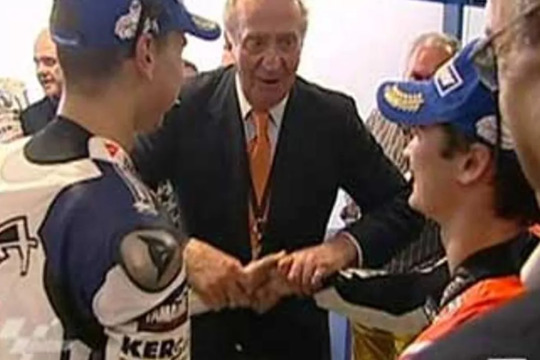
Instead of cleaning the air in between them or cleaining their image it made it all worse. It looked like they couldn't be in the same room if they weren't forced to share the space.
On track they keep fighting hard against each other, more cleanly this time, and still with the same mentality as in 125cc and 250cc. If I can't win because there are other riders doing/having a better day than me, at least I have to beat Dani/Jorge.
Allegedly, 2008 was the worse point in their rivalry, but when asked them directly, they was the period of time between 2008-2010. Their rivalry got to that point it split the whole country. People were genuinely asking if you were Team Dani or Team Jorge. There are still videos of young Spanish riders having to choose (the Márquez used to be die hard Dani fans and Rins was team Jorge all the way).
Little by little, after fighting so much and for so long against each other, and sharing so many space and podiums together, their relationship moved from bitter rivals, to just rivals, to the rival I respect. Dani said that for him the big change was 2012, when their championship fight was the closes. Dani realized that he had been fighting his whole life with Jorge, therefore, they are as good as the other. Their rivalry had made them grown as riders because they had to outsmart and be better on track than the other, so it was a hats off moment.
In 2012 we also had the first physical approach between them. It was also in Qatar when they hugged for the first time, and it was a symbol of them finally burying the hatchet.

2012 also gave us the iconic marriage proposal (please watch the whole video, it explains Pedrenzo rivalry up to 2012).
From then on, their relationship improved a lot. It could also be that they both had change their managers by 2013, so part of what it set their rivalry wasn't in the equation anymore. They also had grown from kids to adults!
In 2015 Dani invited Jorge to Sete Gibernau's (ex-ride, and Dani's friend and coach) 'ranch'/track for a training weekend among other riders. Jorge ended up getting injured, and Dani went out of his way to check on him because Jorge was fighting for the championship. He got injured in the collarbone and Jorge himself admitted it was dumb because he just wanted to win against Dani when racing with smaller bikes. Apparently Pedrosa was miles faster than any other riders (Rins was there and I think the Espargarós too are mentiones
In 2018, when it was announced that Jorge was moving from Ducati to Honda and was going to replace Dani, Jorge tried to convince Pedrosa to stay in the championship by switching to the Petrona's team. It was pretty public with Jorge saying how a much smoother bike will suit Dani's riding style. Ultimately, Dani decided he didn't want to break anymore bones or suffer, so he retired.

Jorge and Dani exchanging helmets at the end of the 2018 season
After MotoGP Now they have a pretty good relationship. They can be in the same room and laugh and talk for hours about racing, including their 250cc races. Jorge will be the one pulling all the monts and remembering the weirdest stuff and Dani will look bamboozled because he doesn't remember that. In fact, among all DAZN's pundits, Jorge is the one that makes Dani smile and talk the most.
They're pretty quick to mention the other rider when possible (specially Jorge), and they are pretty open when asked about their battles in and out of the track. In fact Jorge will jump at any opportunity to mention and praise Dani. Dani will need a bit more of coaxing, but he will also talk and praise Jorge.
Now that the know parts are about, I want to share some thought I have about them.
I think this imatge basically summarizes their relationship. And creditto Jorge Lorenzo himself for putting it together.

First photo is pretty early in their relationship. You can see that they aren't interested in each other. It's basically a photo for the media. The middle one is Jerez 2008 and you can see how forced their handshake is. The king gets the wrong hand, and all of them are confused and wants to be done with it. And the last one, it's more than a handshake. They are truly happy and comfortable around the other. They want it.
Waru's thoughts I think young Jorge was really mad at Dani and wanted to win Dani no matter what due to the different way they got into the championship. All red tapes were broken for Dani. His ages was overlooked when he entered the Movistar Cup, when Jorge had to wait until he was 15 to make his debut. Dani had Puig who saw him and decided to bring him to the top, despite not meeting the criteria that was set, while Jorge had to fight and crawl all his way up. Yes Jorge got a manager and his dad, but he also had to prove himself over and over while Dani could flop and Puig would have still been at his side. It's also the relationship between Dani and his dad. Antonio was there to guide and support Dani, but at the end of the day it was Dani who took the decision, while Jorge didn't have a great relationship with his dad. Chicho acted more as a coach than a dad.
And then when Dani got the 125cc tittle, he got the ColaCao add, that made him look as the good boy that hasn't broken anything, while Jorge had the bad boy label. Dani had everything he wanted, DORNA's approval as he has come thought a DORNA's approved championship, a good relationship with his dad, a great mentor and a team behind. Basically it could be seen as DORNA had picked Dani to be the next Spanish winner at the big category (see why I translated Elegido para ganar as handpicked to win?) and instead, Jorge was the one who did it.
So yes, I think Jorge saw Dani having everything he had fighter for, and not having had to fight as hard as hi. So apart of all the things mentioned above, I think there was a bit of jealousy involved too. But well this is what I think, I might be wrong, but the way Jorge reacts when the ColaCao add is mentioned is prove that there was more there.
And here is all the chronology. If you think I forgot anything let me know! Also feel free to add things if you want.
#MotoGP#250cc#125cc#Dani Pedrosa#Jorge Lorenzo#Pedrenzo#Pedrenzo Chronology#DaniLoveFest2024#DaniLoveFest#ummm didn't I write a similar post recently?#For this reason I think Permín is so Pedrenzo coded there are so many parallels
84 notes
·
View notes
Text
How to Read 108: A Chapter-by-Chapter Death Note Analysis
Hello everyone! Welcome back to second part of my analysis on Death Note’s first chapter, entirely dedicated to everyone’s favorite mass murderer, home boy Light Yagami!
Chapter 1: Boredom. Lilith’s Breakdown. Part 2
Establishing the protagonist:
Light and expectations
Light’s resignation
Light’s cognitive dissonance
Establishing the protagonist
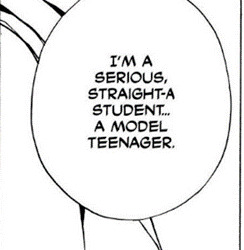
In A Guide to Screenwriting Success, Stephen Duncan refers to them as the character who drives the story forward, who makes the key decisions that affect the plot, often being the one who faces the most obstacles. The OSU College of Liberal Arts says they are the character whose fate matters the most, and usually the emotional heart of the narrative.
There are many definitions one can find online about what a protagonist is, the most oversimplified ones defining the protagonist under the same veil as the hero. But most of us here know that isn’t quite how it works. Still, even though we might be used to anti-hero protagonists by now (Deadpool, Saitama, Dr. House to name a few…) straight-up villain protagonists are rarer to come by, and, most specially, they usually don’t come by in the form of a teenager--or look anything like the guy in the picture above-- which is perhaps the main thing that makes Light stand out in a sea of manga MC’s and remain culturally relevant.
Light is a blueprint of his kind, becoming the point of comparison for other animanga protagonists that fall through a moral decline. To showcase how Light differs from even his own architype, I’m going to be taking three of some of the most famous examples in media and intermittently compare them to Light Yagami in this analysis: Macbeth from Shakespeare’s Macbeth, Rodion Raskolnikov from Fyodor Dostoevsky’s Crime and Punishment and Star War’s Anakin Skywalker.
Light and expectations:
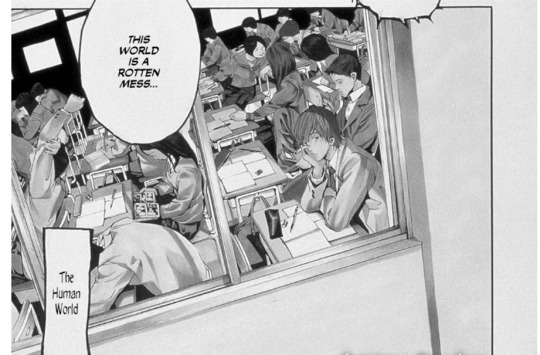
As we had seen in my previous post, we begin the story with a schoolboy disconnected from his immediate surroundings, his whole posture and expression reflecting the “boredom” that it’s the title of this chapter. His status as protagonist highlighted by the fact that he’s the only one looking directly at us. While all his classmates distract themselves with things inside the classroom (their friends, their books, their phones, or simply sleeping) Light gazes out the window, almost as if hoping that something external will offer more intrigue than the monotony of his current situation.
And he gets his wish! A notebook falls from the sky. We know what happens next. Light picks it up, as it is the only thing that’s interrupted his ennui. He’s initially unimpressed by it, although he commends whoever did it for at least committing to the bit.
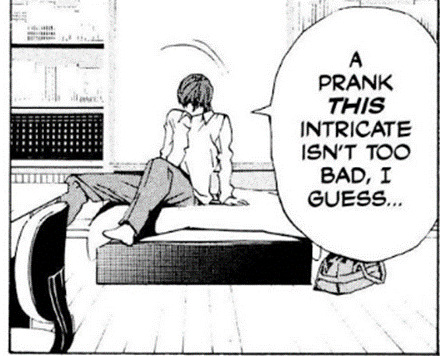
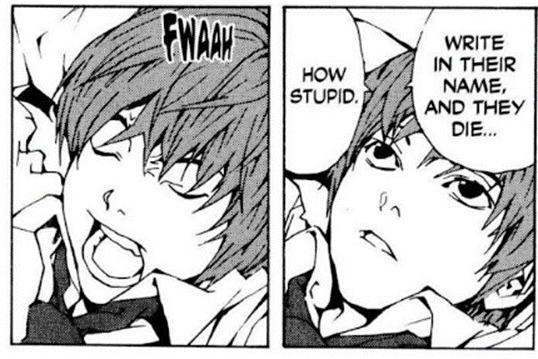
Ohba doesn't reveal the true outcome of the event right away. Instead, he makes us wait, fast-forwarding five days before slowly unfolding the details. This deliberate withholding of information is a recurring technique throughout Death Note, fueling the tension and intrigue that characterizes the manga, leaving us eager to piece the puzzle together.
But the next set of panels is what I want us to take a closer look at this chapter:
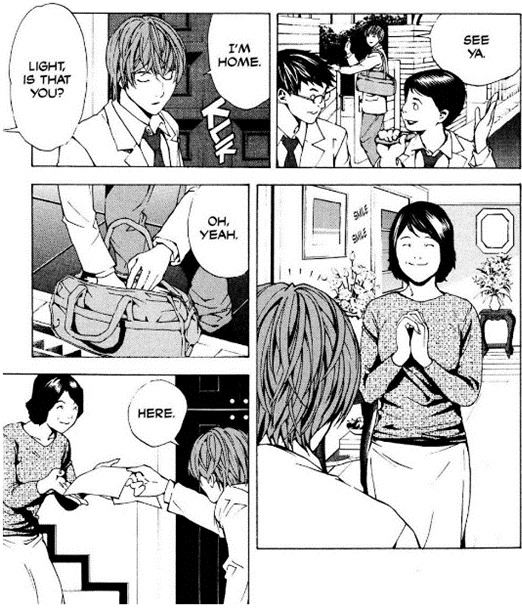
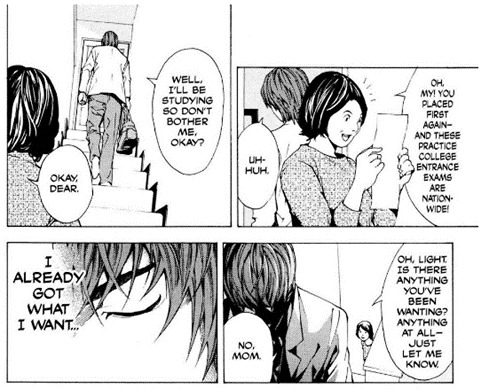
If you know anything about Japanese culture, you’re probably aware of the immense importance that academic success has on a japanese student’s life. To give some context to what’s happening here, I’ll quote Independent researcher Steve Bossy on his report Academic Pressure and Impact on Japanese Studies from 2000:
“In 1872, the Meiji government introduced a public educational system that made higher education accessible to anyone who was intelligent enough to qualify. (…) The entrance examination became the sole instrument by which all students were measured. Tokyo University became the pinnacle of academic achievement and the gateway to future success. Only the most intelligent students were admitted and upon graduation were rewarded with the best jobs. (…) The university entrance examination is the gatekeeper that provides access to and ultimately determines students' future success and status. The university that a student attends is most often the sole criterion that employers consider in their decision to hire a potential candidate.”
It’s no wonder, then, that Light’s mom has been eagerly waiting for his results on the practice exam for this life-determining test. Although we have to take into account, Sachiko says he has placed first again, so his parents are pretty used to his academic success, and Sachiko was just eager for confirmation on her son’s competence. Light is so used to this by now he does not demonstrate any pride or enthusiasm about having placed first nationally on the practice test for what is arguably the most important exam of his life. Perhaps he might have, were it not for the much more significant matter occupying his mind at the moment, though I doubt it. As we’ve already firmly established: Light is bored.
So, we have already identified one expectation Light has: he is presumed to excel academically. By Japanese society standards, this is a promise his parents see of his successful future.
This is then reinforced by what his cram schoolteacher is shown to say in the flash-back: Light wasn’t just Japan’s number one in that sole mock test, he is already Japan’s number one student.
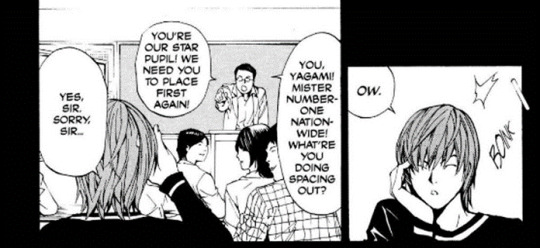
We can then add a new expectation:
Light is expected to keep his place as top nation-wide student and elevate the standing of the schools he attends.
Light doesn’t seem to find this to be such a difficult task though, considering the nonchalant way he brings the results to his mother. He is assured to attend the most prestigious university of the country, so then why, we may ask, does he even attend a prep school in the first place?
We can find the answer here:
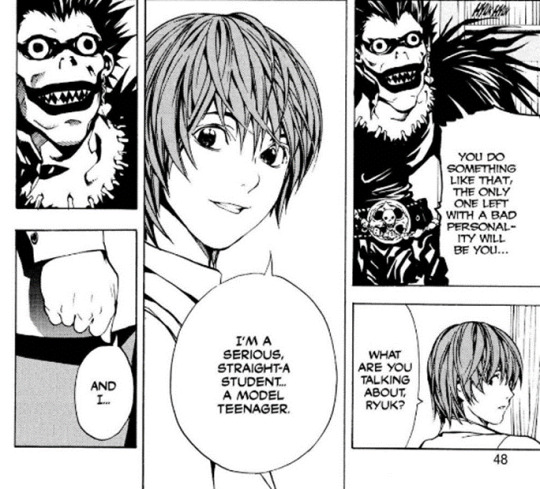
In Japan, it is common for students to attend supplementary classes due to the intense competition within the education system and the critical significance of the entrance exam. So even top students like Light would be expected to attend these types of schools to give themselves an edge. Or as Light puts it: Serious, straight-A, model teenagers. This is who Light is—what he expects of himself and what everyone else expects of him: to embody the ideal of what a Japanese boy should be, to serve as a model others look up to, the standard by which they should shape themselves. Academically focused, respectful of authority, socially responsible, and attuned to societal norms.
Light’s resignation:
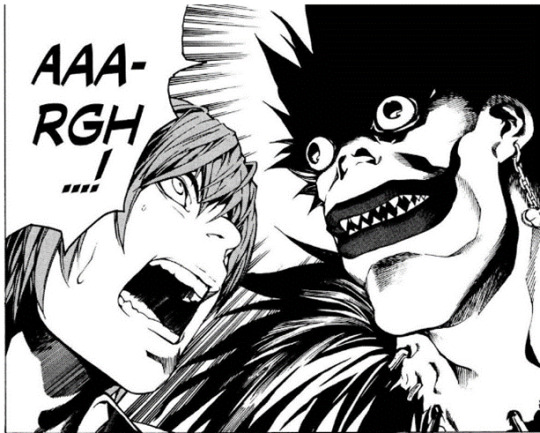
Now that we have established who Light Yagami is, let’s examine more of his initial thought process when presented with the seemingly impossible reality that the random notebook that fell from the sky is, in fact, a supernatural murder weapon.
As previously noted, we don’t immediately learn about Light’s reaction to his discovery. Instead we meet him again after he’s had five days to process his experience. Then Ryuk, whom we’ve already met, shows his rather unpleasant face to an unexpecting Light, and scares the pants out of the boy.
Or so it seems.
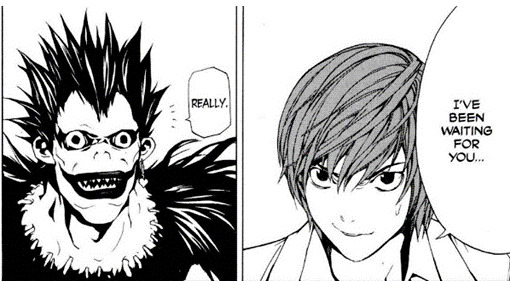

Despite the initial scare, Light has had the foresight to attribute the notebook to a Shinigami, and supposedly had been waiting for them to show up. Light, at this point, had fully accepted the supernatural explanation, and braved with a resolved face whatever consequence it might bring.
But how did Light recognize the connection to a Shinigami, and what does that mean in Japanese culture? The evolution of the concept of death is a fascinating subject, and while I recommend further reading on the topic (such as this article), to summarize: Shinigami are said to be the Japanese Grim Reaper, a relatively recent addition to their folklore, much as the Grim Reaper is for the West, and it was produced as a result of the increased interaction of these two cultures. A difference is that, traditionally, they are less seen as harvesters of souls but as creatures who ensure the smooth running of the cycle of life, performing their duty without malice and remaining morally neutral.
The Shinigami in Death Note are a fusion of these traditional Japanese beliefs and Western, particularly Christian, cautionary tales. This blending of cultural influences is a prominent theme throughout the manga (and anime), which I will explore in more detail in future entries.
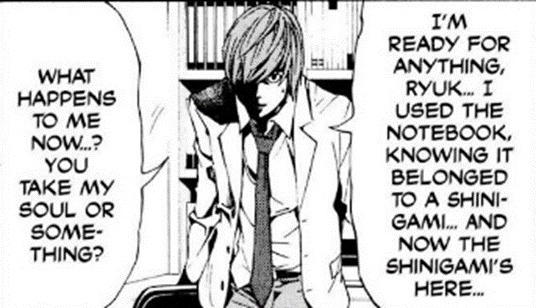
But let’s go back to our protagonist. While both the Western Grim Reaper and the Shinigami ultimately bring death, Light doesn’t seem daunted by this prospect. This raises an important question: Did he have a plan to convince a literal god like Ryuk to spare him, or was he content with having made a difference, however brief? As Ryuk points out:
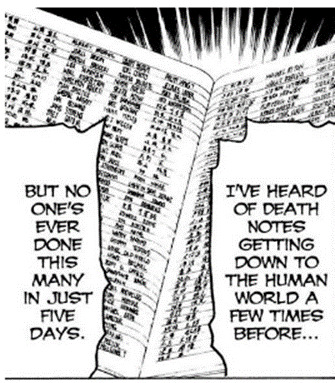

Ryuk, a timeless entity for all we know, singles Light out among what could be centuries of Death Note users. This continues to drive the point for the audience of Light being an extraordinary individual, now not just by his intelligence, but by his adamant determination.
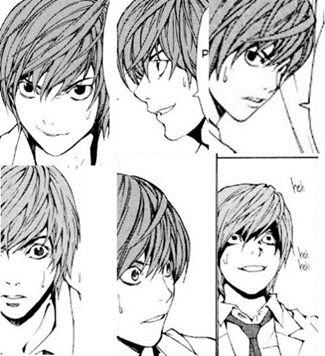
However, Light’s apparent perfect composure in this scene is not entirely genuine. He is sweating profusely through this whole interaction--something that we will rarely see from him in the rest of the story. It makes sense, for its his life at stake here. But it gives us an insight into Light’s ability to suppress his natural human emotions in favor of retaining a sense of dominance and control. At this point, Light really cannot have any idea of what awaits him, or how to bargain with a being like Ryuk, yet he is intent on directing the exchange in his own terms. He even has a prepared Q&A:
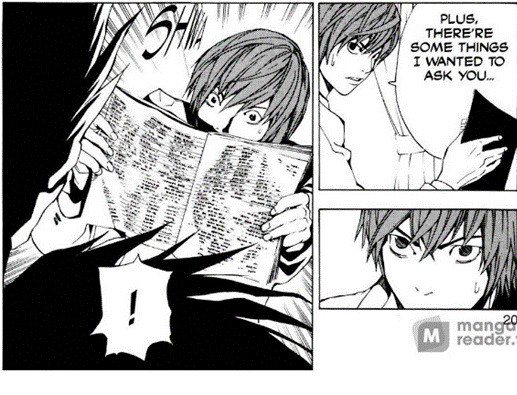
I know the dramatic way in which Light swooshes open the notebook is sort of hilarious, but upon re-read, it made me think further upon this display with Ryuk. We know Light thought it wasn’t chance but choice that made Ryuk give him the Death Note, so did he want to demonstrate his worthiness to the Shinigami? His fearlessness? Did he have a whole speech planned on why he should be allowed to keep using the Death Note? After all, we learn seconds later that he had already formed his long-term plan of ruling the world, so did he plan to offer his soul, in pure Faustian manner, for the chance to wield the Shinigami’s power?
In the end, Light learns that there is nothing he has to offer—no bargain to be made. Instead, the conditions of the Death Note say he will experience fear and torment (which he has already done), that Ryuk will write his name when he dies (which results in the same thing) and that he can go to neither heaven nor hell.
This last one could be considered the greatest sacrifice, upon first read. But it is also a pretty neutral consequence that doesn’t promise reward nor suffering. Of course, it isn’t until the final chapter that we learn it isn’t really a sacrifice, as every other human shares the same fate.

Hence Light’s ecstatic look.
There is then a subversion to Christian narratives by keeping Ryuk��s role neither malevolent nor benevolent. He does not actively tempt Light to keep using the notebook, and even gives him a way out by offering the option of giving it to another human if he doesn’t want it. He has no interest in convincing Light of anything. This is similar to the role of the three witches in Macbeth, who instigate the narrative by sharing a prophecy, but do not manipulate or coerce Macbeth into taking any specific action. However, a key difference in the start of this story and that of Macbeth’s is the idea of destiny. Ryuk mocks Light for believing himself special, in contrast to the witches assuring that Macbeth would be a King. Light's confidence in his potential to rule the world is entirely self-driven, rather than being shaped by prophecy or fate.
Light’s cognitive dissonance:
Ah, we’re finally at the pivotal moment of this first chapter. The moment that will define Light’s character for us moving forward.
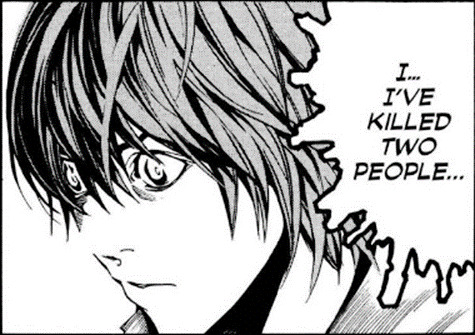
So finally, after Light’s interesting conversation with Ryuk we are thrown back into the flashback that explains how he came to write all those names. The events go as follows: Light was bored, so he decided to write a name on the strange thing he brought home-- just for the sake of it. Despite mostly believing the notebook to be a prank in bad taste, as a strategic thinker, he immediately envisions possible scenarios where it could be real and plans his actions accordingly. He even berates himself for this:
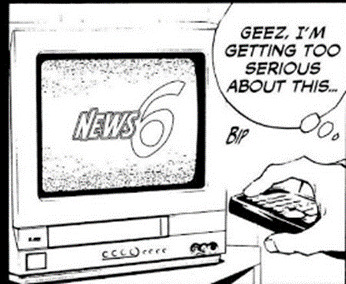
But of course, the Death Note works, exactly as the instructions said.
Up until this point, Light’s actions could be entirely written off as an accident. Kind of like a child shooting a gun because they can’t discern the danger of it. But the event is so monumental, so outside of normal bounds that Light’s young and curious mind cannot simply leave it be and risk another murder. He needs answers and he needs answers now.
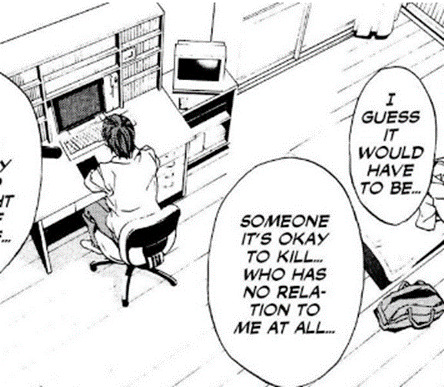
Light is fully aware that his actions are socially reprehensible, which would explain why he decides to continue acting by himself. Not to mention the ridicule, too, were he to hand the notebook to the police and it turned out to have been just a coincidence. And Light Yagami is not socially reprehensible and he is not ridiculous. But there is something else, too.
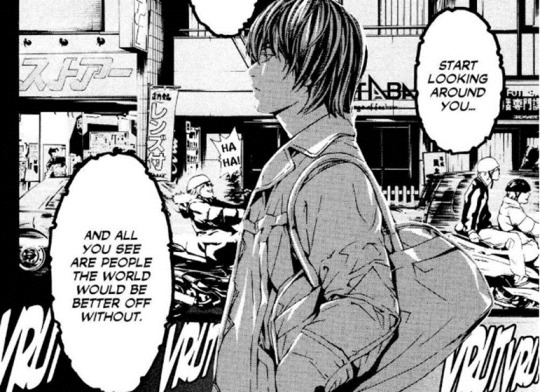
Light Yagami feels detached and high above the world.
It’s natural, as he literally is above his peers in at least the standard by which they are more strictly measured. In a culture where academic achievement is synonymous with social value, Light’s intellectual superiority is reinforced by his position as the model student, but he is also a 17-year-old with a skewed sense of long-term consequences and proportionality, reacting with his amygdala to his immediate environment instead of keeping on with the cool rationality he believes himself to possess. An example of this is when he considers killing one of his fellow classmates for bullying and coercion. A rather minor offense when compared to the criminals Kira would first execute, and directly contradicting the first precaution he’d already thought for himself: to not kill anyone directly associated with him.
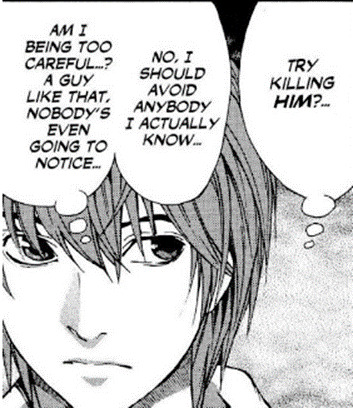
But then he conveniently finds a perfect target, another one that he can justify to himself in the context of preventing a heinous crime.
When the Death Note works once again, it finally confirms Light as a murderer, and this is when the cognitive dissonance takes place.
In psychology, cognitive dissonance is a mental conflict that occurs when your beliefs don’t line up with your actions. This discomfort motivates individuals to reduce the inconsistency, usually by changing their believes, justifying their actions, or minimizing their importance.
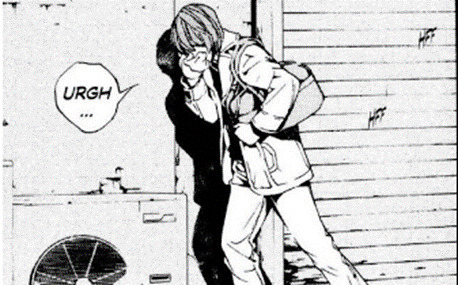
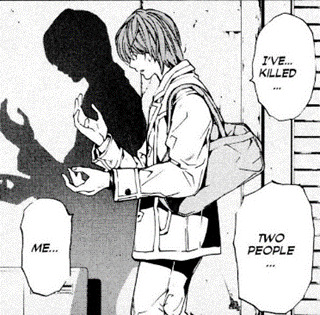
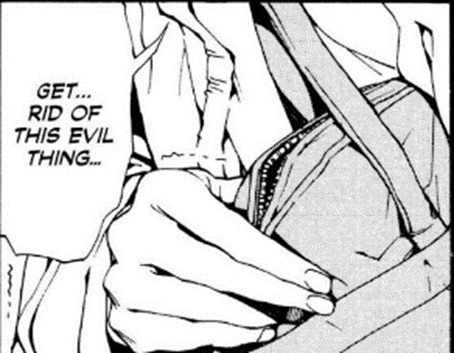
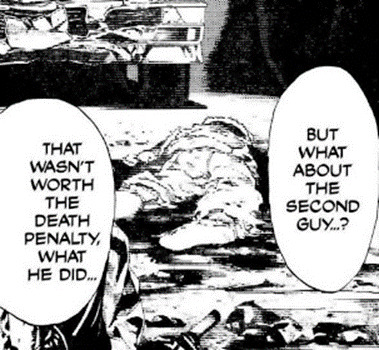
Light’s cognitive dissonance almost makes him wretch, makes him question himself and consider throwing away the Death Note, which he refers to as an ‘evil thing’.
But he begins to resolve this dissonance by reframing his believes in order to justify the new image of himself as a murderer. Light’s inner conflict plays out over at least a day, during which his conscious mental battle is not whether what he did was justified, but whether or not he will be able to take on the role that would justify it.
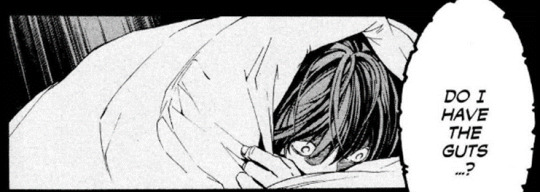
In the end, if he doesn’t take the role of a vigilante, he would have to face the breaking of his self-schema as a moral and upstanding citizen. But the decision to continue killing would also transform him into something else. This conflict between morality and identity is so strong those first few days, that Light admits to having persistent nightmares and loses 10 pounds in 5 days. But ultimarely, the dissonance is resolved with a perfect, if delusional and self-aggrandizing, moral justification: Not only is it right to become the world’s judge and executioner, but he is the only one capable of doing so.
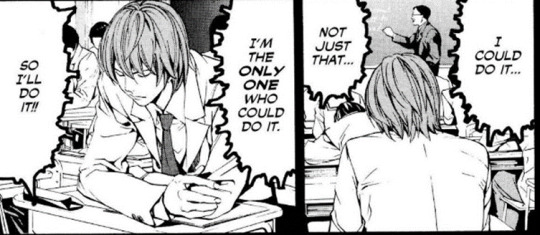
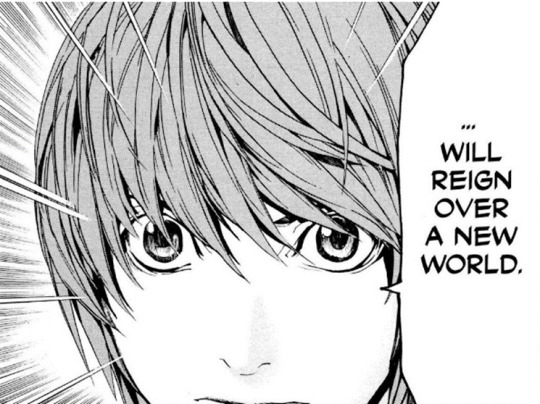
An extraordinary cognitive re-structuring and self-deception in a relatively short amount of time. But then again, we have already reiterated throughout this meta that Light is not an ordinary individual.
And who better, honestly, to carry us through this particular story? What are the limits of these character’s self-justification? What are the consequences of a God’s power in the hands of a mere human? And what happens when a brilliant mind has to contest with a teenager’s inflated ego?
I wasn’t expecting to have this much to say about the first chapter, I’m looking at the page count of this document with a bit of terror, honestly, but it just goes to show how strongly Death Note manages to establish its main themes from its opening and all the questions it leaves the reader with, inviting us to take part of this unconventional psychological thriller.
If you read up until this point kudos to you and I hope you enjoyed my brain’s rambling, I would love to hear your thoughts and feedback. I don’t know if next entries are going to be this long, but I am enjoying finding new things to ponder about this series, that I hadn’t even thought about after 5 years of being a fan!
Next entry! Chapter 2: L. Lilith’s Breakdown
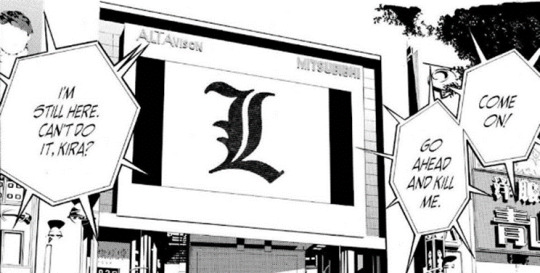
Previous entry: Chapter 1: Boredom. Lilith’s Breakdown. Part 1
42 notes
·
View notes
Text
Recently, I was using Google and stumbled upon an article that felt eerily familiar.
While searching for the latest information on Adobe’s artificial intelligence policies, I typed “adobe train ai content” into Google and switched over to the News tab. I had already seen WIRED’s coverage that appeared on the results page in the second position: “Adobe Says It Won’t Train AI Using Artists’ Work. Creatives Aren’t Convinced.” And although I didn’t recognize the name of the publication whose story sat at the very top of the results, Syrus #Blog, the headline on the article hit me with a wave of déjà vu: “When Adobe promised not to train AI on artists’ content, the creative community reacted with skepticism.”
Clicking on the top hyperlink, I found myself on a spammy website brimming with plagiarized articles that were repackaged, many of them using AI-generated illustrations at the top. In this spam article, the entire WIRED piece was copied with only slight changes to the phrasing. Even the original quotes were lifted. A single, lonely hyperlink at the bottom of the webpage, leading back to our version of the story, served as the only form of attribution.
The bot wasn’t just copying journalism in English—I found versions of this plagiarized content in 10 other languages, including many of the languages that WIRED produces content in, like Japanese and Spanish.
Articles that were originally published in outlets like Reuters and TechCrunch were also plagiarized on this blog in multiple languages and given similar AI images. During late June and early July, while I was researching this story, the website Syrus appeared to have gamed the News results for Google well enough to show up on the first page for multiple tech-related queries.
For example, I searched “competing visions google openai” and saw a TechCrunch piece at the top of Google News. Below it were articles from The Atlantic and Bloomberg comparing the rival companies’ approaches to AI development. But then, the fourth article to appear for that search, nestled right below these more reputable websites, was another Syrus #Blog piece that heavily copied the TechCrunch article in the first position.
As reported by 404 Media in January, AI-powered articles appeared multiple times for basic queries at the beginning of the year in Google News results. Two months later, Google announced significant changes to its algorithm and new spam policies, as an attempt to improve the search results. And by the end of April, Google shared that the major adjustments to remove unhelpful results from its search engine ranking system were finished. “As of April 19, we’ve completed the rollout of these changes. You’ll now see 45 percent less low-quality, unoriginal content in search results versus the 40 percent improvement we expected across this work,” wrote Elizabeth Tucker, a director of product management at Google, in a blog post.
Despite the changes, spammy content created with the help of AI remains an ongoing, prevalent issue for Google News.
“This is a really rampant problem on Google right now, and it's hard to answer specifically why it's happening,” says Lily Ray, senior director of search engine optimization at the marketing agency Amsive. “We've had some clients say, ‘Hey, they took our article and rehashed it with AI. It looks exactly like what we wrote in our original content but just kind of like a mumbo-jumbo, AI-rewritten version of it.’”
At first glance, it was clear to me that some of the images for Syrus’ blogs were AI generated based on the illustrations’ droopy eyes and other deformed physical features—telltale signs of AI trying to represent the human body.
Now, was the text of our article rewritten using AI? I reached out to the person behind the blog to learn more about how they made it and received confirmation via email that an Italian marketing agency created the blog. They claim to have used an AI tool as part of the writing process. “Regarding your concerns about plagiarism, we can assure you that our content creation process involves AI tools that analyze and synthesize information from various sources while always respecting intellectual property,” writes someone using the name Daniele Syrus over email.
They point to the single hyperlink at the bottom of the lifted article as sufficient attribution. While better than nothing, a link which doesn’t even mention the publication by name is not an adequate defense against plagiarism. The person also claims that the website’s goal is not to receive clicks from Google’s search engine but to test out AI algorithms in multiple languages.
When approached over email for a response, Google declined to comment about Syrus. “We don’t comment on specific websites, but our updated spam policies prohibit creating low-value, unoriginal content at scale for the purposes of ranking well on Google,” says Meghann Farnsworth, a spokesperson for Google. “We take action on sites globally that don’t follow our policies.” (Farnsworth is a former WIRED employee.)
Looking through Google’s spam policies, it appears that this blog does directly violate the company’s rules about online scraping. “Examples of abusive scraping include: … sites that copy content from other sites, modify it only slightly (for example, by substituting synonyms or using automated techniques), and republish it.” Farnsworth declined to confirm whether this blog was in violation of Google’s policies or if the company would de-rank it in Google News results based on this reporting.
What can the people who write original articles do to properly protect their work? It’s unclear. Though, after all of the conversations I’ve had with SEO experts, one major through line sticks out to me, and it’s an overarching sense of anxiety.
“Our industry suffers from some form of trauma, and I'm not even really joking about that,” says Andrew Boyd, a consultant at an online link-building service called Forte Analytica. “I think one of the main reasons for that is because there's no recourse if you're one of these publishers that's been affected. All of a sudden you wake up in the morning, and 50 percent of your traffic is gone.” According to Boyd, some websites lost a majority of their visitors during Google’s search algorithm updates over the years.
While many SEO experts are upset with the lack of transparency about Google’s biggest changes, not everyone I spoke with was critical of the prevalence of spam in search results. “Actually, Google doesn't get enough credit for this, but Google's biggest challenge is spam.” says Eli Schwartz, the author of the book Product-Led SEO. “So, despite all the complaints we have about Google’s quality now, you don’t do a search for hardware and then find adult sites. They’re doing a good enough job.” The company continues to release smaller search updates to fight against spam.
Yes, Google sometimes offers users a decent experience by protecting them from seeing sketchy pornography websites when searching unrelated, popular queries. But it remains reasonable to expect one of the most powerful companies in the world—that has considerable influence over how online content is created, distributed, and consumed—to do a better job of filtering out plagiarizing, unhelpful content from the News results.
“It's frustrating, because we see we're trying to do the right thing, and then we see so many examples of this low-quality, AI stuff outperforming us,” says Ray. “So I'm hopeful that it's temporary, but it's leading to a lot of tension and a lot of animosity in our industry, in ways that I've personally never seen before in 15 years.” Unless spammy sites with AI content are stricken from the search results, publishers will now have less incentive to produce high-quality content and, in turn, users will have less reason to trust the websites appearing at the top of Google News.
13 notes
·
View notes
Text
What is animanga Before Crunchyroll
This is a period in time roughly from 2005-2014 when the world is fully post-internet and Japanese anime and manga was already fully integrated into international youth culture and readily available to people outside of Japan.
Animanga fans had access via legal offline channels such as: television, home video, libraries, and bookstores. And illegal online channels such as: Youtube, pirate streaming sites, and torrenting. It is also a period with a sudden change in our general media viewing and reading habits impacted by events and technological innovations like the 2008 financial crisis, the introduction of social media as a primary way to be online, smartphones, and the slow death of live TV
Why start this period in 2005?
This page will be primarily dedicated to the English language distribution and fandom around anime and manga. By this point in time we are well beyond the stage of “evangelizing” animanga as mediums and a canon of “must watch/read” series has already been established.
The above mentioned channels were well established and readily accessible. Depending on where you lived you had a higher chance of being able to go to the bookstore and read the latest Fruits Basket volume, go to anime conventions, watch anime on TV, or join your school’s anime club, than in say 1996. The media industry in several countries outside Japan has or will soon start investing in the distribution of translated animanga for the first time ever. The US manga bubble spearheaded by Tokyopop is also still a few years from bursting.
From this point on online fan communities dedicated to anime and manga also steadily expanded via forums, database sites, to eventually meme aggregator sites, or facebook groups around 2010. In 2005 Geocities pages dedicated to sharing information are mostly dead and platforms such as Livejournal become the new place to engage in fan activities and access unofficial translations until the site was en masse abandoned following its 2009 acquisition by SUP Media
Why end this period in 2014?
Short version: 2014 is when the Naruto manga ended a mere 2 years after the Bleach anime ended its Japanese broadcast. Marking the end of the chapter on a seemingly endless period where every week without fail you could expect not just a new chapter of the manga, but a new episode of the anime version for the mega hits Naruto, One Piece, and Bleach. Kids today will thankfully never know what it was like for years have all of these series as a constant presence in 2 mediums simultaneously. This trio was controversially called the “Big 3” by fans. I could also easily leave it to the fact that of course after 9 years fans have obviously grown up and moved on and the face of the industry itself is completely different. But was just the medium that changed? What about the way international fans interacted with it? I will now present my case on why we can use the popularity of Crunchyroll as a service to make a pre- and post- era in the way international fans consumed animanga.
When the US manga bubble burst after the 2008 financial crisis there was a massive shift in which manga was licensed. The publishers that survived the collapse had to downscale their output leading series to be cancelled or go out of print for several years. The cost of manga also went up turning translated print manga into bigger investments for consumers. Another major shift is online fan translations (scanlations) becoming more prominent and accessible, with new aggregator sites appearing one by one. Not only could you read as much manga as you wanted for free with unedited art and a translation that felt more “authentic”. The high output from the fan translators revealed not just how much manga was not being licensed; the international publishers were often really far behind and much slower than the original Japanese serial.
The popularity of scanlations has always caused obvious tension to the decisions on what US publisher would license as companies like Viz Media and Vertical inc repeatedly expressed the belief that fans would never buy a title they already read for free online. It isn’t an exaggeration to say that as the fansubbers of the 1990s proved, unpaid fan translators were and still are the most significant tastemakers and gatekeepers of Japanese media for an international audience.
This sets the stage for what i personally believe forever changed the way international fans watch anime (and in turn read manga): social media and the premiere of Kill la Kill and Attack on Titan. Prior to this the average international animanga fans experienced anime rather delayed. There is little awareness of what was actually new in Japan and to the average fan watching anime recommended in online or offline communities may have been enough. But how many official channels like TV, video rentals, and home video sales were actually available as distributors went out of business or lost their licenses how was a fan supposed to watch the series they wanted to see? And what if you didn’t even live in a country with any of these official channels? Fansubs or DVD rips uploaded to Youtube, torrenting sites, or other unauthorized streaming aggregators successfully democratized access to anime for anyone with a stable internet connection. The high output of fansubbers just like scanlators also revealed again just how far behind the official channels were. Why wait for the right to purchase something when you know you want it and can just get it for free online?
Enter Crunchyroll: the site was founded in 2006 as a for-profit media hosting site for east asian media. A lot of the media hosted was unauthorized and illegal but some distributors chose to look the other way. This was until Crunchyroll started securing more and more funding in turn letting them enter legal partnerships and distribution deals. Eventually striking gold with partnership with Studio Gonzo and the acquisition of the Naruto Shippuden anime rights. Eventually all unauthorized media was removed from the site as they built a catalogue of anime for consumers to legally stream, at a price. In parallel to this, by 2012 fansubbers could and were expected to keep up with just about every new anime airing in Japan.
Another change happened in our daily lives: smartphones became a piece of technology most people owned. And the abrupt consumer shift from live TV to streaming was right around the corner.
A gradually acquired awareness of just how far behind and slow official “legal” channels were was already completely reshaping the way the most avid fans viewed anime. So was our new phones. The smartphone wasn’t just good for watching anime while you were away from home it also made reading manga online an even easier experience. How were the official distributors supposed to compete with this?
Unfortunately most pirate streaming sites were slow to implement players that functioned on smartphones, Youtube was also not far from implementing an aggressive DMCA strike system preventing new anime uploads. A service like Crunchyroll became more and more attractive as it was available in almost any region outside of Asia. With a big catalogue of titles that put Netflix and hulu to shame and a smartphone app that worked smoothly, it didn’t seem like a bad deal for people who wanted to watch anime on their phones or other devices, not to mention the premium gave you HD quality. A luxury the illegal sites couldn’t always grant. And it offered what previously only fansubbers could: you got to see brand new episodes of subtitled anime only an hour after it aired in Japan. It’s second major selling point to younger and less financially free individuals was that free users could watch as much as they wanted as long as they sat through ads, were fine with SD quality, and being 1 week behind on brand new anime.
Socially the immediacy and size of large scale social media like Facebook, Tumblr, and Twitter cultivated bigger and bigger and more public communities. It became more and more commonplace to not just watch and read whatever was recommended to you but to keep up as well as finding the next cool thing before anyone else. So what channels would keep you updated on everything new? Trustworthy sources were for many still difficult to discern. More and more fans were watching new anime at the same time as Japanese viewers via illegal and legal channels, but what would it even look like if everyone watched the same show the same time as Japanese viewers?
When Attack on Titan premiered in April of 2013 we learned. Its immediate success was unprecedented and shocking. In a matter of weeks previously unprecedented changes happened within the official channels. Not only could the US industry observe how overnight every online community was discussing this new series, Crunchyroll who streamed the series from episode 1 could provide them the actual numbers proving its success. For the first time the dub specialists Funimation would offer an unsubtitled and ongoing series for sale on iTunes. Kodansha America as well had lucked out by licensing the manga over a year prior giving the US industry another rare example of how a successful anime can give a previously niche series an unprecedented boost in sales. For fansubbers and anime and manga aggregators to keep up if a hit like this was to occur again they had to somehow work faster than Crunchyroll, or just steal from them.
Attack on Titan i think was the first time such a huge group of people all at once learned and experienced how to keep up with a brand new anime and still ongoing manga. October the same year Kill la Kill, an original story and the first work by Studio Trigger directed by the already acclaimed Hiroyuki Imaishi premiered. Once again there was an unprecedented amount of attention from international fans given to a series that was still airing in Japan. This new desire to be part of a series as it was happening was not just significant to the way international fans started viewing and evaluating anime and manga but also new opportunities for the industry to make a profit by investing more and more into “simultaneous” streaming
I didn’t read all that, sorry
Fans come to expect instant access to brand new anime and manga -> Crunchyroll is the only service able to fulfill that expectation and can do it faster than a fansubber -> in 2013 an unprecedented hit opens the eyes of the industry and anime fans alike -> now discussions and trends among international fans of anime and manga is more than ever centered around what’s “new”, a huge shift from when awareness around “newness” was vague or less relevant to how international fans interacted with animanga
How will you qualify an anime or manga as B.C. (Before Crunchyroll)
This blog and its polls will be primarily centered on the offline and online English speaking fan communities. English Second Language speakers are included in this.
Any survey will include works that received translations (official as well as unofficial) into the English language. And with consideration of these criteria
If anime: did it air on TV in the US, Canada, UK, or Australia? If so when and through which channels. Because the aforementioned delays in distribution this will matter more than when it first aired in Japan. I will continue to make 2005 my start point but exceptions might be made for series that were in some way rereleased or put in long term syndication. 2014 is the end point because of the above mentioned changes in how a lot of us watched anime was completely changed by this point in time.
Did it receive a fansub? When and by which group(s)? Identifying the groups also allows us to map out who were the tastemakers and what they wanted to make accessible to other fans. This is very key for anime that sustained popularity despite not being accessible through official channels for extended periods in the years 2005-2014. Also if you don’t live in the countries listed above it was most likely the only way you watched anime.
How often did it appear in “Anime is life” collages? (VERY IMPORTANT DATA!! how else are we supposed to quantify its cultural impact)
If manga: was it licensed by a US publisher? If so when and by who? This also matters more than when it was serialized in Japan. Viz Media’s Shojo Beat and Shonen Jump, and Tokyopop’s catalogue are very defining of the first half of this era and shaped our manga starter pack years after they stopped existing.
Did it receive a scanlation? When and which group(s)? Once again key to identifying the true tastemakers starting around 2010. Scanlations were not just key in bringing fans brand new manga hot off the Japanese presses faster than a US publisher could, but was very important in making manga that were neglected by publishers accessible in English.
Any criteria you want to suggest or already use yourself to determine eras of animanga? Or perhaps your own memories of this time? Feel free to share!!
#long post#introduction#people who were on livejournal are especially encouraged to share their experiences!!
102 notes
·
View notes
Text
Kaiju Week in Review (October 1-7, 2023)
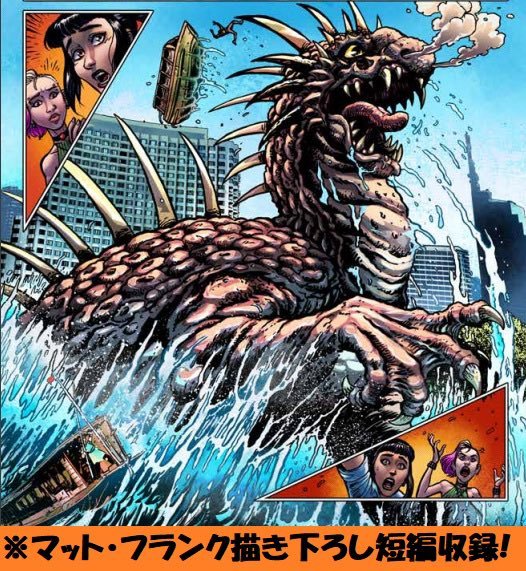
Godzilla: Rulers of Earth has evidently been a huge hit for Japanese publisher Phase Six, kicking off a lengthy run of translated and original kaiju comics. They'll be releasing the first 12 issues in a ReMonstered Edition hardcover on Halloween. It's ReMonstered because Matt Frank made some tweaks to his art, although he promises he "didn't, like, replace guns with walkie talkies." The real prize, however, is a new six-page story called "Thinking On Our Feet", starring Lucy Casprell, Kristina Sumres, and Varan! Longtime readers know that I am Not Normal about the Rulers of Earth lesbians and will probably have to import this reprint of comics I already own, as an English release for the six-pager is just a dream right now.
EDIT: @starestream points out that IDW is reprinting all of its Godzilla comics in giant Library Editions, and they haven't done Rulers of Earth yet. (Volume 1, which came out a couple days ago, gathers Gangsters & Goliaths, Legends, and The Half-Century War.)
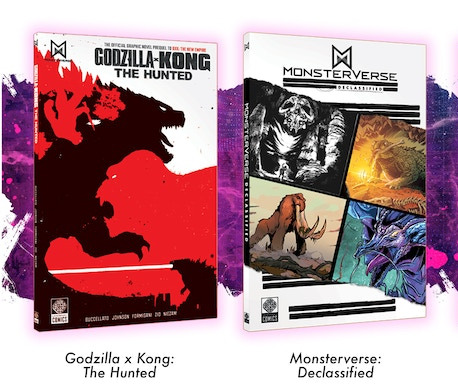
Legendary Comics launched a Kickstarter for hardcover editions of two Monsterverse graphic novels: Godzilla x Kong: The Hunter and Monsterverse Declassified. They've already vaulted over their goal, unsurprisingly. If you're content with paperbacks, the main news here is a little more information about the comics. Oh, and a glimpse of a new Titan on the cover of Monsterverse Declassified that the campaign studiously avoided naming. (Supposedly it's Abaddon.)
Synopsis for Godzilla x Kong: The Hunted:
A twisted Skull Island trophy hunter baits his trap and sets his sights on the biggest game of all deep within the Hollow Earth in the official prequel graphic novel to the upcoming film Godzilla x Kong: The New Empire.
Synopsis for Monsterverse Declassified:
Discover the legends of four fan-favorite Titans - Doug, Behemoth, and Tiamat, plus one to-be-revealed Titan! Join Bernie Hayes as he takes readers down the rabbit hole to reveal classified Monarch secrets and ancient monster myths in the first-ever Monsterverse anthology!

Godzilla: Here There Be Giants #4 has the series poised to end on a high note, bringing in the Giant Octopus in its final pages. (It's called Oodako here, which is a name I never expected to see in official media, seeing as it just means "giant octopus" in Japanese.) Amazingly, this is its first time fighting Godzilla, despite debuting in a Godzilla movie all the way back in 1962.
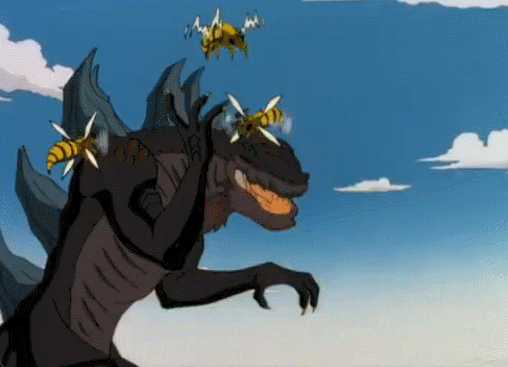
If you live in the States and were hoping to see Godzilla Minus One in IMAX, bad news: Renaissance: A Film by Beyoncé is now opening on December 1 as well, and IMAX preorders for it have already started. Godzilla's taken on a Queen B before, but concert films are suddenly box office gold (Taylor Swift: The Eras Tour is poised to open with $125 million domestic, higher than any 2023 superhero movie). The subtitled period piece doesn't seem to stand much of a chance, Godzilla or not. Still, keep an eye out.
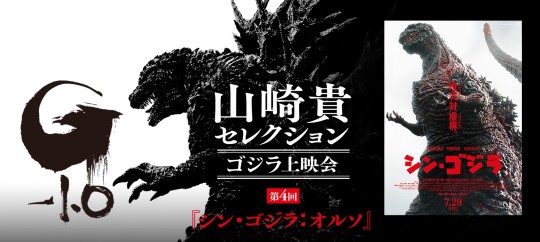
A black-and-white version of Shin Godzilla called SHIN GODZILLA:ORTHOchromatic will play in a handful of Japanese theaters on the last weekend of October. I'm guessing the film has been regraded (the announcement mentions that Shinji Higuchi and AD Katsuro Onoue supervised the project), so changing the settings on your TV won't perfectly replicate it. But it's a hell of a lot cheaper than a plane ticket.
#godzilla#godzilla rulers of earth#varan#kaiju week in review#shin godzilla#godzilla minus one#giant octopus#monsterverse
49 notes
·
View notes
Text
Thai BL: The Fanservice Problem...
Now here's the thing... I'm not here to offer solutions, though I do have proposed ideas that I may include at the end, but more just to breakdown my thoughts on fanservice in Thai BL.
First, we'll start with a general definition of fanservice:
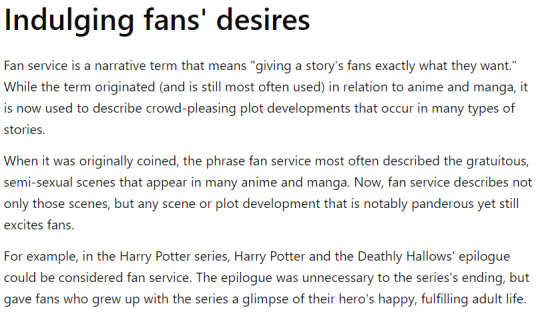
I think that the connection to print media originally is important when we're looking at modern BLs series and movies, as they have a base in print media. In Thailand you have niyaai waai (“Y” novels), kaatuun waai (“Y” comics), as well as the Japanese Yaoi Manga and Korean BL Manwha that are very literally the basis for numerous series, in addition to original story BL series.
In terms of the fanservice we see in relation to Thai BLs...that goes a step further, moving out of the fictional world and into the real one. The fanservice we're now talking about is actors whose characters are couples often being paired for promotional events and they are expected to on some level act similarly to their onscreen characters. This includes individual character behavior, but also having the two actors behave in a way that could be (and is intended to be) read as romantic by fans. This includes a lot of different actions, but skinship (which I'll breakdown later), general chivalrous behavior (like serving your partner first), going on 'dates' specifically with the intention of presenting those experiences on social media. The important part about fanservice in this context is that it is always done with the intention of being seen by fans. It doesn't matter if it's a publicly streamed and hosted event, or just an Instagram post, if it's made public by the actor, or their company, it's intentional and it's likely fanservice.
What is the purpose of fanservice then?
Profit, essentially. For these companies, who both produce BL, but also often represent these actors as a talent management agency, there's a profit to be increased by presenting actors in this way. Having these 'couples' become popular to fans means continued view of future series, but also means that they can set contracts to have them promote various products. You will see the actors often promoting the same products that are used in product placement in their series. A brief list off the top of my head: the Lays chips, whatever that flavored water or juice they're always drinking in Wabi Sabi shows, Epson printers (I think it's Epson), various skin-care serums, L'Oreal hair color, the menthol inhalers, the list is likely endless. In the series, product placement gives them direct funds to actually make the shows, but by having the actors promote the same products, these companies are getting a percentage of that payment also because they are also working as representation for the actor.

To make easy numbers, while Gemini's contract might have been $1000 for this post promoting this brand of Ramen, because GMMTV set-up that partnership/contract, and they represent Gemini as talent, they'll get $200 for themselves, Gemini takes home $800 minus taxes. Again, these are made up numbers and I truly hope that no one is actually getting a 20% commission, but I trust none of these companies, so I honestly wouldn't be surprised if it was higher.
But because this is genuinely how a good majority of production companies gather capital to be able to make shows, the more popular a ship is can directly equal out to how many ad partnerships they can create for them, as well as the price they can charge. In order to give an approximate view, I chose two actors from the same company, Domundi's Zeepruk and Tutor. Because of Zee's vastly higher popularity and the wide difference in follower counts I wanted to have a third actor for comparison, and so I chose PP Krit. It's not an exact match across the board, but I think gives a good view of scale. Here is the break down of their last 30 Instagram posts:
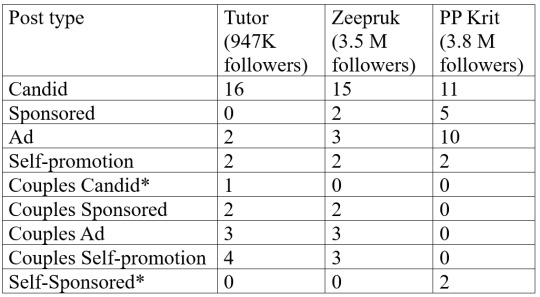
Now I'll start with some definitions of how I categorized things. Ads are things that have clearly been shot specifically to promote a product, and often have instructions in the captions on where to purchase, or specific benefits about the products. Sponsored posts are any posts where they tag a brand in the caption, but it doesn't have the detail of the Ad posts, or posts of them at a place or event where they were invited to attend by the brand for the purpose of being photographed there. Self-promotion is trailers, photos from their series, or fan events. And finally candid is any pictures that are just there for the fun, thirst traps, vacation pics, pics from behind the scenes of events, and while few of these are actual 'candid' pictures, they're not for the purpose of promoting a 'brand' in particular (outside of the fact they are all clearly intend to promote the 'brand' of the actor). The Couple+ 'whatever' is the same as listed above, but is for any posts that include the other half of their acting pair (meaning Yim, Nunew, and Billkin). The Couples Candid is only found once on a post from Tutor, and is clearly taken when they were filming their Tiktok BL short, but there's no tags for the short series, nor instructions on where to watch it, so I'm calling it a candid post. For PP Krit, there are two posts that I'm categorizing as 'Self-Sponsored' as one is for PP's own brand (Caremate) and the other is for a Car Repair shop owned by a family member. Later when I do math with this information those posts won't be included in the 'potential profit' as I can't guarantee he was paid, and if he was I doubt he charged his standard rate.

Looking at Tutor 7/30 of his latest Instagram posts are ads/sponsored and 5 of the posts are 'couple' posts, meaning they also feature Yim. For Zee 10/30 are sponsored and 5 of those are 'couple' posts also featuring Nunew. It's also relevant that the earliest post I counted of Zee is from April 8, 2023, for PP is April 6, 2023, and the earliest one from Tutor is from December 6, 2022. Given that we have about 30 posts from Zee in 2 months, I'm simply not going to scroll back to December to see what the comparison is time wise, but if the ratio remained the same 10/30 in 2 months, that would equal 30/90 over 6 months, with 15 being 'couple posts'. So you can see the difference made in terms of money brought in by more 'popular' actors. If we stick with our $ 1000 per post cost for individual posts, and double that for 'couple posts' ($ 1000/per actor) that's $ 45,000.00 total brought in and $ 9,000 kept by Domundi as commission. For Tutor, in the same 6 month span, he (and partially Yim) brought in $ 12,000, with Domundi keeping $ 2,400 as commission. That's a marked difference for Domundi. And completely ignoring the very high likelihood that Zee is probably bringing in 2 to 3 times what Tutor his because of his popularity and longer time in the industry. If we look at those same number with PP, he has 15/30 posts that are Ad/Sponsored, at $ 1000 per post that's $ 15,000 directly in PP's pocket essentially, since he has his own independent company that represents him. Which causes it's own complications, as he has many more sponsored and ad posts on his company account, many of which he also appears in with Billkin. (Sidenote: I actually find it fascinating that there's no sponsored/ad posts featuring Billkin on his personal account, in fact it's surprisingly rare for him to post Billkin on his account at all outside of stories, at least recently.) So all of this to say, you can see how having these actors promoted in pairs is more profitable for the company as far as ad promotion.

The additional benefit is we're looking at is fans being able to follow pairs through different stories. Like many fans of media, we will often find actors we enjoy, and then proceed to actively work to watch different projects they are in because we like them, find them to be incredibly talented, think they're handsome, etc. This general expectation is capitalized on by companies by having pairs act opposite each other in multiple stories. At this point for ZeeNunew and TutorYim, we've seen both in the Cutie Pie series, but both also have future work to look forward to. I've previously mentioned the BL Tiktok shorts with TutorYim, and they are going to be the leads in Middleman's Love, which is due to come out at the end of the year. ZeeNunew have a new film, After Sundown, as well as new series The Next Prince, and will be returning as Lian and Kuea in Naughty Babe as second leads. All of these future shows and series are produced by Domundi, meaning they will get a portion of profits from appearances, merchandise, etc. that goes along with those series, as well as the potential ads or product placement in the shows. There’s also a high likelihood that product placement in Naughty Babe will garner a higher price, as it’s a spin-off of an already popular show with already popular actors, where Middleman’s Love, as the first series showing Tutor and Yim as leads, would be ‘cheaper’.
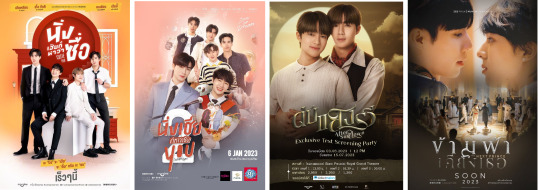
Fanservice as perceived by Fans
Now this can be difficult to break down, because it all depends on the fan. Fanservice as a concept is widely understood by Thai fans. They actively recognize that it exists, and they enjoy it. Other East Asian countries also recognize that Thai BL employs fanservice, and while they accept and enjoy it, they generally do not want to see the practice taken up by BL actors in their own country. In fact, it’s generally rare for actors in BL series in Japan, Korea, Taiwan, etc., to have actors paired for multiple series, outside of appearing as the same characters over various series. The first to come to mind is the characters of Bo Xiang and Zhi Gang from HIStory 3 having in a small guest appearance in HIStory 4, played by the same actors, Wilson Liu and Zhang Han Yuan. Because they are rarely kept as an acting pair, fanservice outside of the actual scripted media is not expected and would have little benefit.
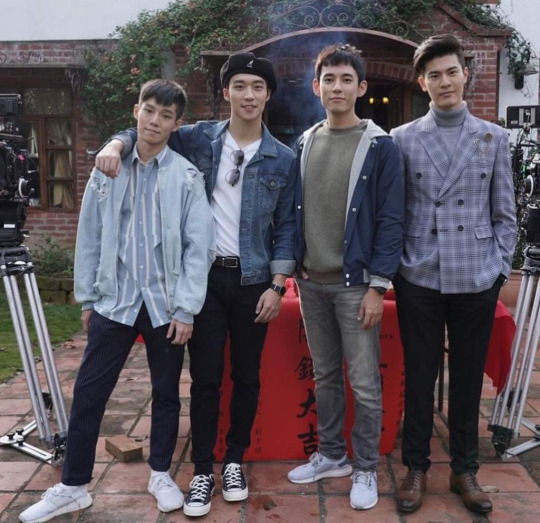
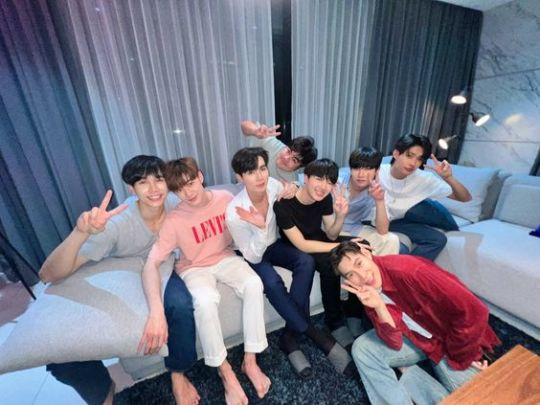
Moving away from East Asian, very particularly to Western, audiences where fanservice is something that many media consumers ONLY expect to see in the media itself, never outside of it. Speaking as a western fan myself, I was genuinely surprised at the amount of ‘bonus content’ that is the expected norm with Thai BL’s. The fan meets, sponsored events, concerts, the vlogs and excursions, the behind-the-scenes content, all of it is generally beyond what I am used to as an avid media fan. Director/or actor commentary, behind the scenes documentaries, while popular generally fell out of favor with the decrease in popularity of physical DVDs, as it was originally intended to be a selling point of purchasing DVDs instead of VHS. (But honestly, that’s a different post.) And observing the behavior as someone with the perspective of a western fan, it is both the requisite behaviors of fanservice, as well as the difference in cultural norms, that causes confusion and blurs lines. The number one thing that is seen as surprising by western fans of East Asian media, is skinship, particularly skinship between two men.
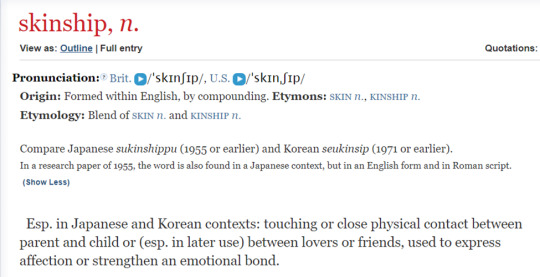
The concept of skinship isn’t directly unfamiliar to western people but is generally something that occurs between direct family members (parent-child or siblings) or between romantic couples. In East Asian culture it’s moves beyond familial and romantic bonds to include all platonic bonds as well. You can expect to see skinship practiced between any two people who are close and feel affection for each other. So, in the context of fanservice and Thai BL acting pairs, not every occurrence of skinship (hugs, holding hands, sitting especially close, playing with hair, fingers, etc.) is fanservice, but it is a tool in the fanservice armory. Given that it is a cultural norm, and that many of these actors are at least well known to each other and friendly, it is likely an easy one to enact in the name of fanservice.
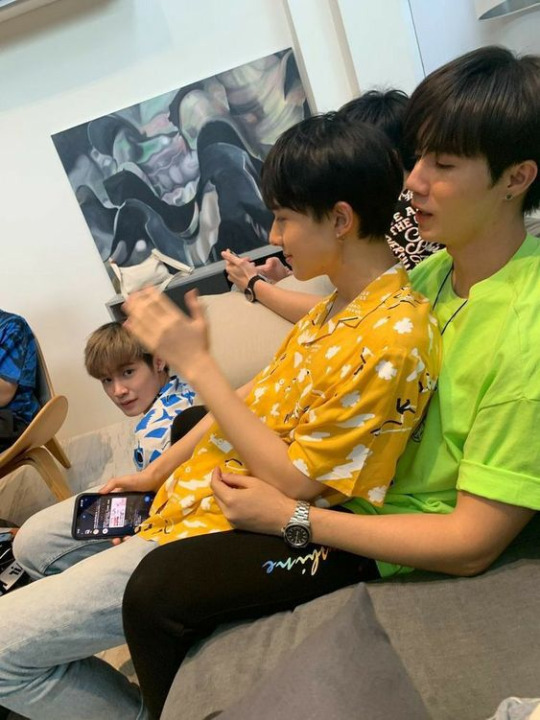
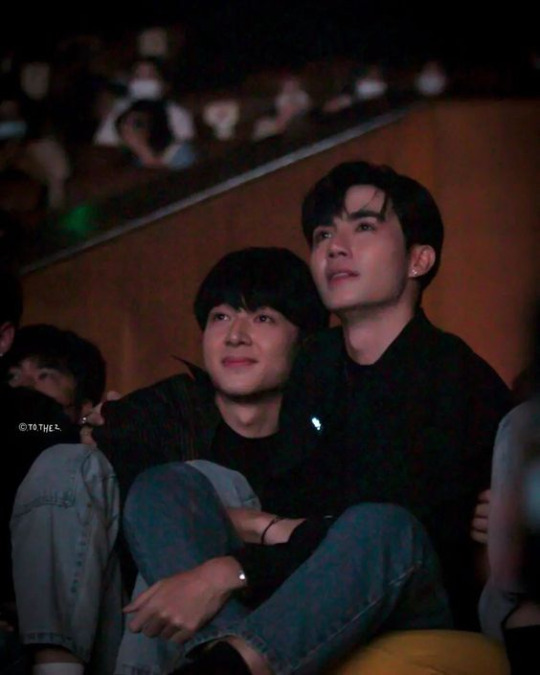
Watching these interactions through a western lens however, causes the viewer to more easily see the behavior in a romantic context. And there’s honestly a lot of factors that play into that, the biggest being ‘masculinity ideals’ where most western cultures don’t promote or encourage men to show affection outside of family (generally strictly parents or children) or romantic couples. Then you also have good ol’ homophobia, men don’t want to show too much affection towards other men for fear of being seen as gay. And this is a very broad sort of description, as the ‘norms’ for what is acceptable platonic contact will of course differ in immigrant families, or indigenous communities, or among black Americans, even just geographically. I’m just a white person speaking from their own experience and observation, though I do have the benefit of knowing, working with, and interacting with a remarkably wide variety of humans.
Why is Fanservice a ‘Problem’?
If it’s widely understood that fanservice is an extension of the acting, that it’s very often something required by contract, that it’s not an indicator of a romantic or sexual relationship, then it’s not a problem. But that’s not widely understood. And that lack of understanding or even the preference of fans to ignore that knowledge has created a problem in the Thai BL industry. We’ve watched over the last several months personal attacks on actors for ‘queerbaiting’ (which is a term intended ONLY for fictional characters), fan clubs being upset over actors going to appearances alone or without the other half of their acting pair, personal attacks on close friends of actors (very particularly female friends), and even the attacking of an employee and friend of an actor for ‘pushing the fanservice agenda’. What is intended to be cute and fun, is turning into something that is having real life negative effects, both on the actors themselves, but also people connected to these actors. It’s also spreading beyond Thai BL, with fans (mostly western fans) being upset at non-Thai actors for not engaging in fanservice.
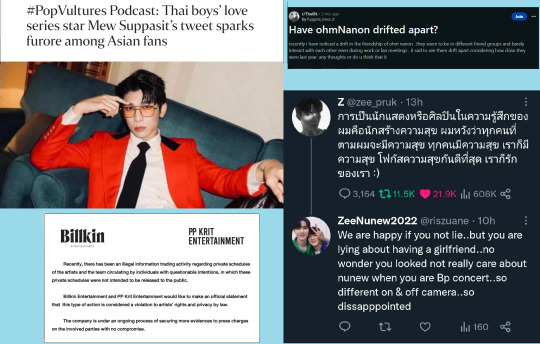
Fanservice, by virtue of it being monetizable, also indirectly exploits the Queer community. This is something that’s recognized and often brought up by western fans, as culturally, we’ve reached a point where the expectation is that Queer media will cast Queer actors in roles. This is done specifically in an attempt to help Queer actors to get more roles in the entertainment industry in general (which is a worthy goal) but is also only considered in the context that while being an out Queer person in the West is easier/safer than in many other places around the world. Many Western nations have not only marriage equality, but anti-discrimination laws that give additional protection to Queer people. And even with these laws there are still hundreds of thousands of Queer people who don’t feel comfortable being openly out in all aspects of their lives. In many East Asian countries, legal protection against discrimination is not guaranteed, and even in those countries with anti-discrimination laws, there’s often caveats. And that’s completely setting aside societal discrimination, which would be a top concern for these actors. Taking Thailand specifically, homosexuality isn’t illegal, but there are no laws in place for marriage equality or even the recognition of same-sex relationships. While there are anti-discrimination laws in place, those rest on the ability of a Queer person to PROVE discrimination, which opens its own can of worms.
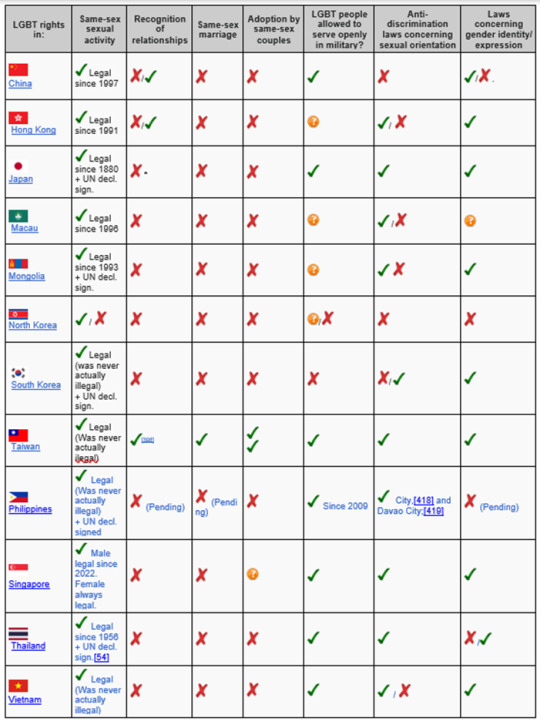
So, what I’m saying in regard to monetizing or exploiting the Queer community, is that it is understandably frustrating for actual Queer people in Thailand to see actors ‘performing’ queerness through fanservice, and being rewarded for it, while many regular citizens are living in situations where being out could be damaging to their livelihoods, cause loss of friendships or family relationships, and even put them in physical danger. Now, are some of these actors part of the Queer community? We know for certain that some are, we know for certain that some aren’t, but the vast majority we don’t have any concrete knowledge of their sexuality or Queer identity (and we are NOT entitled to it!). But it would be understandable and reasonable, given the current political and societal landscape of many of these countries, that any actor would have to very seriously consider potential ramifications of being out. Like any Queer person anywhere, there’s a laundry list of considerations that have to be addressed. Top of the list is ‘Would I be physically safe if I came out?’ but you also have to consider possible negative effects on your career, the potential limitations if you want to move outside of BL to mainstream content. We also have VERY clear examples of societal discrimination and hatred towards openly Queer actors, both from ‘local’ fans as well as international fans. But we do very often see BL actors being openly supportive of their local Queer community, promoting proactive voting in elections, and even this past week making appearances at PRIDE events. This is in addition to potential work they are doing quietly to support the community, like donating to non-profits that work to assist or advocate for Queer people, both individually and as a whole.

So, What’s the Solution?
I have no idea. I stated in the very beginning that I’m not here to give solutions. (That’s above my pay-grade.) But I do have some ideas. Now, these are not going to be the easiest for many BL fans to hear, I’m sure. They bother me too, to be honest.
I think an excellent first step is to have companies be upfront about whether fanservice is part of actor’s contracts. We know for a fact that BOC does not contractually obligate fanservice, but any other production or management company that works in BL more than likely does, though the scale and level of expectation may vary. I don’t 100% know if this would actively work, at least initially, because the actors themselves are aware that fanservice can help to raise their popularity, which enables them to be contracted for ads, sponsored social media posts, and appearances, which is how most of these actors make the majority of their money, NOT through the pay they receive for their actual acting work. So, they may perform fanservice as it’s currently known even if it’s not contractually required, but I do at least prefer the actors being in control of the level of fanservice they take part in, if any.
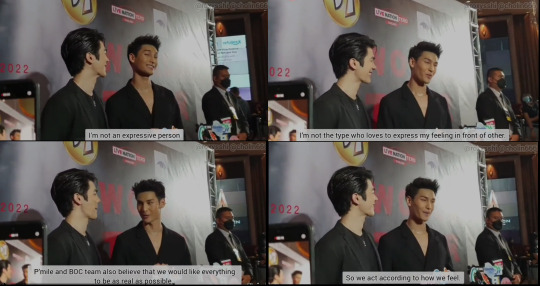
A second step, or option, is to have companies not solely send actors to events in their ‘pairs,’ and not keep them in the same pair for multiple series. I think if a company took the step and intentionally mixed up their ‘pairings’, specifically those from lead roles, then we would see less direct attachment to the ‘pairs’ and more to the actors as individuals. This could help in the long term prevent the fallout we’ve recently seen from acting pairs “breaking up,” very specifically the hateful attacks we’ve seen directed at the separate parties. But I think it could also prevent the fans from ‘choosing sides’ as I’ve also been seeing frequently in online BL spaces. In other direct online discussions, I’ve likened it to having a friend couple break up, and all of the other friends in the group essentially have to pick a side. Sometimes, you knew one person before they were a couple, and you stick with them. On occasion, one of the people will have done something terrible, and even if you knew them first, you stick with the other person. But often these are people who became your friend already a couple, and neither really did anything wrong, they just grew apart…so is it right to throw one aside in favor of the other?? Or is it more reasonable and realistic to maintain friendships with both separately? In a similar fashion, when BL pairs go their separate ways, isn’t it more reasonable to continue to follow them separately, assuming you find them both to be equally talented, versus putting one aside?
As a supplement to my suggestion of not maintaining static pairings I made this lil picker wheel with the actors at GMMTV...
…to be honest I’m quite intrigued by the idea of First and Gun. Both are phenomenal actors. I can picture the vibe of a potential story, based mostly on my desire to see Gun as a homme-fatale. PICTURE IT: Gun is a sultry assassin, beautiful and deadly, First is the ever-weary federal agent on his tail…but he begins to find an interesting connection amongst Gun’s ‘victims’, they’re all users and abusers, arguably far more detrimental to society than Gun himself. As he tracks down Gun and learns more about him…he begins to fall for him. In the end…does he stay true to the commitments he made to his country, or does he breaks those promises in favor of following his heart??
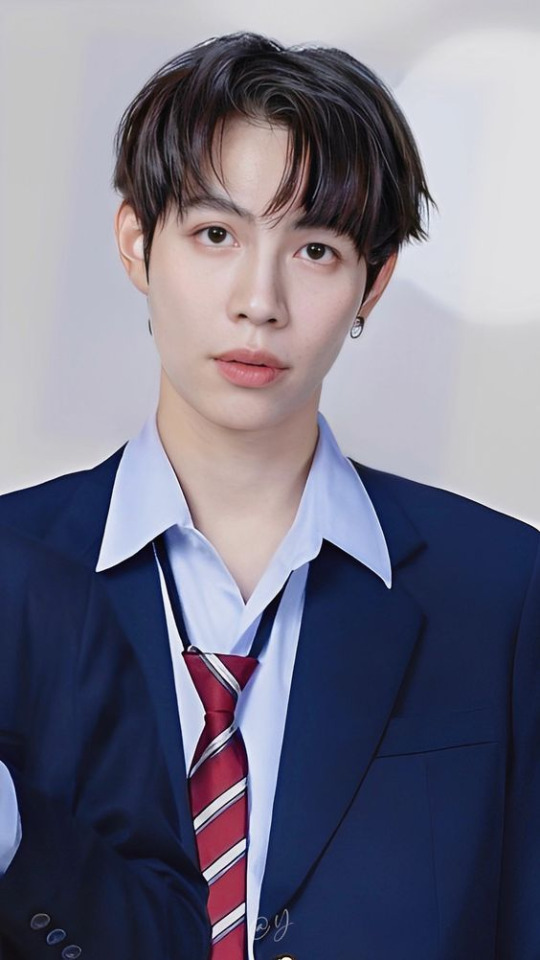
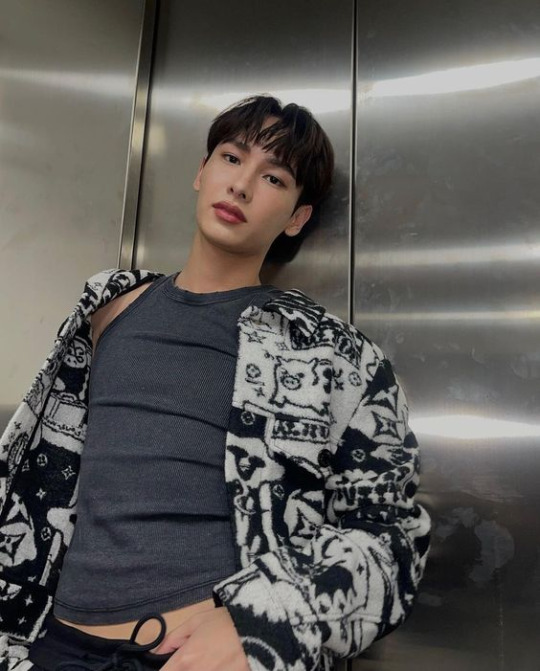
Anyway...this was 3,500 words. Hopefully some of them made sense. PLEASE share your thoughts, if you have any on this subject. I'd be especially interested if you are outside of the US.
#Thai BL#Fanservice#BL Drama#ZeeNunew#TutorYim#BillkinPP#First Kanaphan#Gun Attaphan#I don't know what other tags to put#But I hope you appreciate this#It took me 6 hours#Love Y'all#Tong Thanayut#Domundi#GMMTV#WabiSabi#Be On Cloud#Me Mind Y#Dee Hup House
69 notes
·
View notes
Text
Anime Spotlight #1: Sonic the Hedgehog OVA (1996)

Acquired Stardust's spotlights expand into the realm of anime! Join Ash as she takes a look back at 1996's Sonic the Hedgehog OVA, a fitting first entry in our anime spotlight series, bridging the gap between video games and anime.
In many ways the story of Sonic the Hedgehog mirrors that of developer Sega's due to how indelibly linked the Blue Blur's meteoric rise into pop culture relevancy is to the company at large. Sonic the Hedgehog, much like Sega, went from the cool new contender rivaling Nintendo's dominance in the early 90s to an underdog by the turn of the century, to an example of just how harsh the shift from 2D to 3D games could be to video game developers that struggled to make the transition with as much acclaim as Nintendo had, back to a beloved alternative underdog in recent years that represented a very particular style and sound that you couldn't find just anywhere else.
It's easy to see why Sonic the Hedgehog had such an impact in its initial boom period (which lasted roughly 8 years, from 1991 to 1999) with the strength of the creatives involved and inspirations evoked. Brandishing a visual and auditory edge along with its gameplay and level design that many considered on par with Nintendo's Super Mario, Sonic the Hedgehog helped propelled Japanese video game developer Sega into unprecedented heights particularly in America. Hot on the heels of 1993's Sonic CD and 1994's Sonic the Hedgehog 3 (& Knuckles)released on the Sega CD platform, 1996 saw the release of a two-episode Sonic the Hedgehog original video animation in Japan (that's OVA for those unfamiliar with anime terms, meaning a popular release method that's a sort of direct-to-video release rather than airing on television or in movie theaters). It was also compiled into a single 53-minute video and dubbed by ADV Films when it arrived in America in 1999, coinciding with the release of Sonic Adventure.
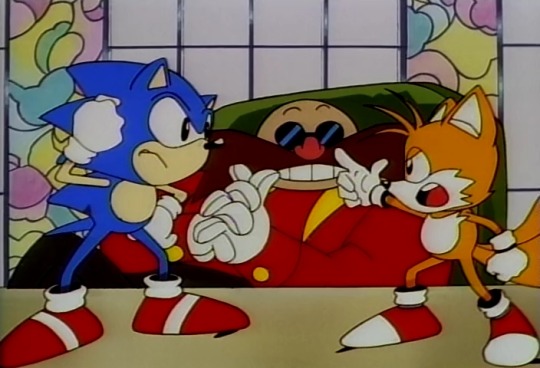
Immediately apparent is the retention of many of the elements that made Sonic so popular in this era. First you have the art style of Sonic CD, recreated faithfully by Studio Pierrot (also responsible for animating shonen anime classics Naruto, Bleach and Yu Yu Hakusho), with the even higher animation quality than the animated sequences of the then-new video game afforded by the budget of OVA format. There's also the soundtrack composed by Mitsuhiro Tada sporting an incredible blend of synthesizer, drums, keys and horns that's still stunning to this day and tragically never released in any official capacity (though an early production reel of the soundtrack, including its clever and catchy main theme sung by Riyu Konaka, was leaked in 2020 thanks to a Russian Sonic fansite). There's also the story and cast, an unthinkable (in 1996) teamup between Sonic and friends with nemesis Dr. Eggman rounded out by a few original characters such as the charmingly feral brat Sara, notably being the first instance of oddly human (or at least in this case humanimal) love interests for Sonic.

As previously mentioned, Sonic OVA nails a lot of things about the series that made it so popular at the time including the portrayal of its lead characters. Sonic has his cocky coolness, Tails lovable kid genius with plenty of vulnerability and Knuckles has both all the toughness and silliness one would expect. Aspects of all three of these characters would come to be either lost of hyperfocused on in the years to come and it's pretty great to have a piece of media capture the protagonist trio in such robust detail, with each character getting several moments to shine and their own significance in the events of the OVA as opposed to being ultimately completely beholden to Sonic to save the day.
Another retention from the video games of the time is the action and sense of speed with Studio Pierrot having done a wonderful job animating not only several sequences of traversal straight out of the Sega Genesis games complete with cameos of enemies along with several impressive fight sequences, as well as a few small instances of impressively thought out interaction between both characters and environment. In terms of the story and animation it's clear that the people involved in the project really understood the assignment and never phoned it in or lost sight of what they were doing.
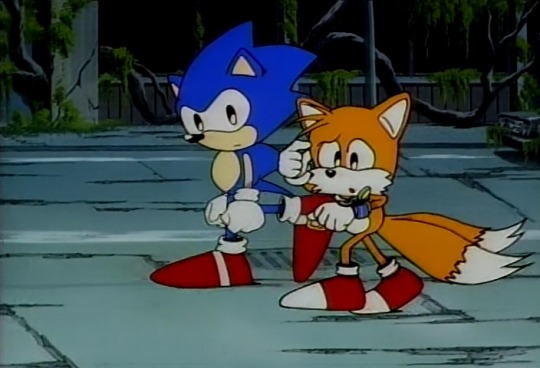
While a wonderful snapshot of the series at the time, Sonic OVA also features a few interesting elements that look to the future. Planet Freedom, the world in which the characters inhabit in this particular incarnation of the series, features a distinctly New York City in post-apocalypse locale that would later come up again in 1999's Sonic Adventure on the Dreamcast. Sonic OVA also positions Tails and Dr. Eggman as more direct rivals than previously seen, which would come to be a staple of the series starting again with 1999's Sonic Adventure. Sonic OVA is not entirely without its own quirks that would not be retained however, most notably referring to Knuckles as a mole and seemingly giving him the ability to outright fly as opposed to merely gliding.
Some may find the English cast to be annoying, but personally this is my favorite casting of the characters and the voices I always associate with them - they're teenage (and in the case of Tails, a child) cartoon animals after all. Regardless of which language you choose to watch in, Sonic OVA is a fantastic time and an interesting snapshot in time that effectively communicates why a lot people had so much fascination with Sega's Sonic the Hedgehog in its prime. It's also not everyday that this era of Sonic's music, largely featuring reworked compositions of Masato Nakamura's band Dreams Come True and later various songs by Michael Jackson (itself an interesting footnote of Sonic development lore), manages to feature tracks that stand up to the mainline games' quality, but Sonic OVA definitely includes a few songs that will stay with you and it's a shame that until recently the soundtrack has been almost completely ignored by Sega.
A gem hidden among the stones, Sonic the Hedgehog OVA is undoubtedly stardust.
-- Ash
#anime#retro anime#90s anime#1990s#sonic#sega#sonic the hedgehog#gaming#retro gaming#video games#studio pierrot#ADV Films#OVA#anime spotlights
22 notes
·
View notes
Note
Those translators really made Volo call us puny.
And for WHAT??
(He's more rude to GIRATINA than the player character! He uses the -san honorific for us, but the very derogatory "omae" for Giratina.)
i've only taken a few Japanese classes to supplement some years of self-study, speaking to a couple of Japanese people, and my short time in Japan, so this is more of my speculating and attempt at explaining based on that (since i'm not fluent and DO NOT have extensive Japanese knowledge). this got kinda long, but i ended up having more to say than i thought, so thank you for reading all the way to the end if you do haha
i think it's pretty normal for Volo to use "-san" for the player. after all, he's a merchant, and it's standard for a salesperson to use "-san" for customers to be polite. probably this is the main reason he uses it.
i've also heard "-san" used commonly across many situations (and as a safe honorific if you don't know how to address someone else yet), even among friends of similar age. it's kinda rude if you don't use it with someone's last name, and you don't really use ONLY someone's first name without "-san" unless they're family or very close to you (though i have experienced Japanese people using only my first name, as a foreigner, which i think is an exception to this). (this is also unless they've specified the way you should address them.)
this is probably just a game thing too, but Volo uses [first name] + "-san" as an exception to this because the player doesn't have a last name.
he's also maintaining his guise as being a merchant, so i think it'd be stranger if Volo didn't use "-san" because he isn't really on that level of closeness with the player to drop it anyway.
however, this whole thing is a bit hard to contextualize because it isn't a realistic situation; in real life, he probably wouldn't speak to a child like this, or even use "-san" at all.
as for "omae," it's a bit difficult to try and explain because i don't think it has a one-to-one translation in English, even though it'd be close to the word "you." it does carry a "rougher" context to it, so it could be considered rude in some situations, but it can also be used between people of equal status, besides when just speaking to someone of lower status. uhh and from actually speaking Japanese, it's pretty uncommon to use a "pronoun" word like "omae" anyway, since people typically just use one another's names instead. it could come off as rude not to use their name in place of a "pronoun" word once you know it. so i think Japanese in media like games and anime is a lot different than daily Japanese, too.
though it kinda makes sense Volo would use "omae" for Giratina. i can only unfortunately look to the English dialogue after you beat them as a reference here, but my interpretation of how Volo sees Giratina is that he believes HE was the one who gave it the opportunity to usurp Arceus. (he does state he was the one who gave it its power and the chance to do so.) so he'd use "omae" to speak to Giratina, as he considers himself the one with the higher status in their relationship. i also wouldn't expect Volo to be polite to Giratina because he's a Pokémon Wielder (ポケモンつかい, Pokemon tsukai, literally "Pokémon user" or "someone who uses Pokémon"), and Giratina is no different to him in that regard.
BUT! there is A LOT of nuance in Japanese that's untranslatable to English, and i think part of their honorific system is one of those things. so i apologize for any mistakes (pls correct me if anyone else who knows more has some input), as i don't think i'm well-versed enough in Japanese to give a lot of accurately detailed input. :U
24 notes
·
View notes
Text
https://www.reuters.com/world/japan/magnitude-74-earthquake-strikes-japan-tsunami-warning-issued-2024-01-01/
TOKYO, Jan 1 (Reuters) - A powerful earthquake struck central Japan on Monday, killing at least one person, destroying buildings, knocking out power to tens of thousands of homes and prompting residents in some coastal areas to flee to higher ground.
The quake with a preliminary magnitude of 7.6 triggered waves of about 1 metre along Japan's west coast and neighbouring South Korea, with authorities saying larger waves could follow.
The Japan Meteorological Agency (JMA) issued tsunami warnings for the prefectures of Ishikawa, Niigata and Toyama.
A major tsunami warning - the first since the March 2011 earthquake and tsunami that struck northeastern Japan - was issued for Ishikawa but was later downgraded and eventually cut to an advisory, meaning waves up to 1 metre (3 foot) high could be expected.
It was the strongest quake in the region in more than four decades, according to the U.S. Geological Survey.
Russia and North Korea also issued tsunami warnings for some areas.
Houses were destroyed, fires broke out and army personnel were dispatched to help with rescue operations, government spokesperson Yoshimasa Hayashi told reporters.
One elderly man was pronounced dead after a building collapse in Shika Town in Ishikawa, broadcaster NTV reported citing local police.
"The snow from the electric wire (came) down, and also from the roof it fell down and all the cars are shaking, and so everybody was panicked," Jonny Wu, a Taiwanese tourist visiting nearby Nagano prefecture for a skiing holiday, told Reuters.
Japanese Prime Minister Fumio Kishida told reporters he had instructed search and rescue teams to do everything possible to save lives, even though access to quake-hit areas was difficult due to blocked roads.
More strong quakes in the area, where seismic activity has been simmering for more than three years, could occur over coming days, JMA official Toshihiro Shimoyama said.
The government said that as of Monday night it had ordered more than 97,000 people in nine prefectures on the western coast of Japan's main island Honshu to evacuate.
In comments to the press shortly after the quake struck, Kishida also warned residents to prepare for more disasters.
"I urge people in areas where tsunamis are expected to evacuate as soon as possible," Kishida said.
The Imperial Household Agency said that following the disaster it would cancel Emperor Naruhito and Empress Masako's slated New Year appearance on Tuesday.A magnitude 7.6 earthquake struck in Ishikawa prefecture in central Japan on Monday
'TSUNAMI! EVACUATE!'
Following the quake, a bright yellow message reading "Tsunami! Evacuate!" flashed across television screens advising residents in specific areas of the coast to immediately evacuate.

Local media footage showed a building collapsing in a plume of dust in the city of Suzu and a huge crack in a road in Wajima where panicked-looking parents clutched their children.
There were reports of at least 30 collapsed buildings in Wajima, a town of around 30,000 known for its lacquerware, and fire engulfed several buildings.
The quake also jolted buildings in the capital Tokyo, some 500 km from Wajima on the opposite coast.
Almost 32,000 households were still without power in Ishikawa prefecture late on Monday, according to utilities provider Hokuriku Electric Power (9505.T), with temperatures set to drop to near freezing overnight in some areas.
Tohoku Electric Power (9506.T) said 700 households remained without power in neighbouring Niigata prefecture.
Telecoms operators also reported phone and internet outages in some areas.
Forty train lines and two high-speed rail services to the quake-hit area halted operations, while six expressways were closed and one of Ishikawa's airports was forced to shut due to a crack in the runway, transport authorities said.
Japanese airline ANA (9202.T) turned back planes headed to airports in Toyama and Ishikawa, while Japan Airlines (9201.T) cancelled most of its services to the Niigata and Ishikawa regions.
NUCLEAR PLANTS
The quake comes at a sensitive time for Japan's nuclear industry, which has faced fierce opposition from some locals since a 2011 earthquake and tsunami triggered nuclear meltdowns in Fukushima. Nearly 20,000 people were killed and whole towns devastated in the disaster.
Japan last week lifted an operational ban imposed on the world's biggest nuclear plant, Kashiwazaki-Kariwa, which has been offline since the 2011 tsunami.
Japan’s Nuclear Regulation Authority said no irregularities have been confirmed at nuclear power plants along the Sea of Japan, including five active reactors at Kansai Electric Power’s (9503.T) Ohi and Takahama plants in Fukui Prefecture.
Hokuriku's Shika plant in Ishikawa, the closest nuclear power station to the epicentre, had already halted its two reactors before the quake for regular inspections and saw no impact from the quake, the agency said.
Monday's quake struck during the Jan. 1 public holiday when millions of Japanese traditionally visit temples to mark the new year.
In Kanazawa, a popular tourist destination in Ishikawa, images showed the remnants of a shattered stone gate strewn at the entrance of a shrine as anxious worshippers looked on.
Kanazawa resident Ayako Daikai said she had evacuated to a nearby elementary school with her husband and two children soon after the earthquake hit. Classrooms, stairwells, hallways and the gymnasium were all packed with evacuees, she said.
"We haven't decided when to return home yet," she told Reuters when contacted by telephone.
9 notes
·
View notes
Note
I think the problem with people's expectations of HPSC stuff is how Western media often portrays Intelligence Organization like CIA or FBI as either the main character (100% good) or utterly corrupt higher-ups organization (CMIIW) while in Japan media that I know (I just know 3 of them but still) Intelligence Organization like HPSC is a direct citation to real-life Japanese PSB (Public Safety Bureau = Keishichō-kōanbu, usually only called Koan, exactly like how people in MHA called HPSC so the reference is definitely intentional) and they're usually a very, very background organization with as little exposure as possible. Those organization are portrayed as shady, trigger-happy, but overall well-meaning... or at least has the same goal as MC but with less... pure way. In Detective Conan and Naruto there's also PSB-like organization, Naruto with ANBU (NOT ROOT, Root is 100% Danzo's private project for his own benefit and corrupt organization) and Detective Conan uses the same name as the real-life organization (PSB = Koan). I watch all 3 of them and those PSB-like organizations are very rarely appear as active parties, they only moved when crisis is approaching (reactive, the reaction is mostly murder but still), at worst secretly building their ammos like weapons or even child soldiers, and occasionally giving MC challenge on obtaining their goal in more ideal way if the author wanna dip their hand at it. BUT if the MC proved themselves that their way can work, those organizations will... let them be. Like, they won't insist that their way is the only right one, they're willing to accept the MC's more moral way as long as it brings good results. That happened with Conan, that happened with Naruto, and I believe that will happen with Deku as well in the ending.
That's why I never think that HPSC will be an antagonist just like I never think that ANBU or PSB will be antagonist for Naruto and Conan. Unlike JJK higher-ups who have been directly portrayed as the main problem since day one, those organizations are never intended as an obstacle to be defeated by MC, just organization that was like "okay, they exist, they can be nasty, but they have the same goal as the MC so MC must do their best to do stuff in ideal moral way so those organizations don't have to move in their own extreme utilitarian way". I am not very good at English hope that makes sense
This is an extremely fascinating write up. I don't have much to add except "lol the reaction is murder" is very funny when it comes to the HPSC and our favorite HPSC murderers (Nagant. Hawks). I will say it's a very dark take on an organization compared to Naruto, which... didn't think things through, but kind of fitting.

This again makes me wonder if Mera's temporary and Keigo's really headed for a career with them in management/leadership?
28 notes
·
View notes
Text
Placeholder Name for Atarase's Media Diary

Entry 004 - Unicorn Overlord <<Prev: NieR Reincarnation
Synopsis
The drums of war are beating. No man can be trusted. What happened to Dorcas? (say it with me) I put poison in his mutton!
Once again I have been falsely advertised to and I will not forgive. (the names used are different since I played in german)
How much did I know before playing?
I played 13 Sentinels for what that's worth and I did play the demo extensively. I played it a month late but went out of my way not to get spoiled.
Also I play Fire Emblem sometimes? the game certainly feels inspired by that
Did I like it more than I expected?
I liked it about as much as I expected to like it, maybe even a little bit more!
Except for one thing, which I had only expected because several "news sites" have reported on it being in there - even providing lists! - only to find out it wasn't in it and that thing is...
Since I liked it, here's what I hated about it
So all that stuff about Male Romance for Alain was a fucking lie. Tell yourself whatever you want but I have higher standards than that - what's shown there is pretty explicitely not Romance, with Male Characters the Ring of the Maiden scenes are very much framed as Friendship Bracelet scenes.
And maybe I'm a little bit more heated at this than I should be, but as is tradition I had once again the patented Vanillaware pleasure of learning this by Surprise Mandated Romance as suddenly after several scenes of sweet and cute moments between him and Alain the guy I chose (gilbert) suddenly - without warning because I did not give a singular damn about Virginia (is that even her name) - announced his wedding to her in between two credit screens.
Like, I was fully okay with not a single blush moment, at this point I still thought this was their take at Male on Male-Romance and I was perfectly happy with what I got, mainly because it's just sadly common for japanese media to cut any intimacy from mlm relationships as soon as they're textually confirmed - but I also had no frame of reference for the other characters, so for all I knew the female ones were just also like that. I sincerely believed that when Alain told him that despite all those political reasons he also just really treasures Gilbert that that was supposed to be read as Romantic even if it was very toned down.
But welp. Vanillaware Surprise Mandated Romance strikes again. This is Sekigahara Ei all over again.
Spurted by this I then did my own research. I tried it with about 10 other guys after the ending - and I even inspected their epilogue overworld dialogue each time!!! - and all of them were very clearly just as non-romantic as Gilbert's, even Lex and Clive who I remembered front and center on those Romance Option lists. The best I got was Adel's epliogue dialogue (which is very cute ngl) and maybe Lex's as well, even though that one was just pretty much verbatim a "Hey, we have a good thing going here...", the vagueness of which doesn't really offset the "Yeah, but No Homo, right??" I had to sit through when giving him the ring right before.
Meanwhile I tried 2 (two) female options to see if it's the same for both genders and while one (Tatianna) was lightly implied to be romantic in the epllogue but mostly the same to the male ones the other one (Primm) was explicitly and overtly romantic. (which is also clearly indicated by blushing and i'm pretty sure only Adel ever blushed in one of the male ones)
It's just. Why? Why even include this if you don't go the whole way. You knew you couldn't or shouldn't just make it female only - but then why do it like this? Why is the Ring of the Maiden so clearly treated as a wedding ring with Girls and then "No Homo Bro, it's just a friendship bracelet with a weird name" with the Boys (and of course you need to make sure that people get how gay uncommon it is to give your friend a ring by pointing it out almost every time). Either you make it all Friendship Bracelets, all Wedding Rings or you make both equally mixed - which would have been more than fine with me too! - but not something stupid like this. and no i don't care if alain is 'supposed to be straight' alain isn't a real person and he's clearly supposed to be self-insertable, but I guess only for straight men
After Takatoshi in 13 Sentinels and now this I'm having some kind of feeling about how Vanillawear includes this stuff. Like it's nice that you're trying to think of these things, but... if this was a genuine attempt on your part then why did you think this was good?
I guess the reason I'm so upset is that the way the Ring is integrated into the story is so fucking cool?? And Gilbert was such a good choice for me to pick too because he fit right into the scene?? I legit didn't realize at first he was just there because of the Ring? And then after all that uwu sincerity I'm No Homo-ed in the credits by a surprise wedding because I guess I missed the moments where they mentioned their relationship... if they did at all (staring into space remembering 13sen, shaking my head at Ei x Iori being written the way it was)
Thank God that's the only thing I really hated about this game, but for another nitpick: I guess the Unit Promotions could have been flashier if they already aren't branching? i guess it's to save work because of the Animation Style but imo Fire Emblem does those better. With some of the promotions here you can't even really see any difference...
What did this game make me think about?
Nothing really in particular but I loved how relatively fresh the writing felt despite not being all that 'out there.' Like, on paper it's a relatively 'basic' story, I wouldn't call it groundbreaking or anything, but the way it is delivered and presented felt fresh, yeah, I think that's the best word to describe it.
Specific Impressions that will stick with me
The Ending Ring Scenes even if they were ruined for me a little bit afterwards q_q I didn't repeat those with other ring partners so maybe I should try it again with Adel and see if they're still as good
I love a game that lets me Sequence Break and I love that this game supports it so much that even the story still makes perfect sense if you do the segments out of the 'intended' order. You better believe I weaseled my way into Bastoria when I saw that there was only a high level fight stopping me from not going to the other regions first.
And whoever decided to let the Character Creator Mirror work on every single character deserves a fucking raise. I made them all look so pretty. Whoever you are, you're a visionary!!!
Outstanding Audio
I loved the Music in Elheim and the Night Music in Albion is really eerie it gave it such a good vibe. Also Drakenheim's final stage music.
Favorite Character
There were a lot of good ones... I loved Sanatio and Nigel. Also Yunifi and the Lion whose name I forgot.
Favorite Arc/Story Line
Albion and Bastoria
In general I loved how individually important the major Story Lines were! Every story line felt equally as valuable and impactful to the overall story, but all in their own unique way!
Favorite Set Piece
Elheim's Final Battle was really cool...! I really loved Elheim's Aesthetic as a whole, especially what we saw of the undercity...
I don't know what exactly I skipped doing it, but in Elheim's Final Stage if you take over the other exits before fighting the Boss, she bumps into your stationed unit while fleeing and I guess you skip a second battle? That's the Presence that Immersion and Suspension of Disbelief people should be talking about!!!
Favorite Scene
Again, the Ring Scenes in the True Ending really hit the spot... if you choose the right person that doesn't immediately break your trust q_q (gilbert found dead for breaking the pact)
Best Performance (I played with JP voices)
I love Sanatio's VA (Mutsumi Tamura) and as the entire reason why I like Sanatio (I was pretty sure that's just Okino again and I was right) I guess I'm obligated to mention her. apparently he's voiced by damien haas in english and i can't and won't even picture that lol (i looked it up and ouch what) (and that's not shade to the VA, that's casting shade, who thought this was a good fit)
Also Shout Out to Raenlys for using Yumi Hara's Mama Voice <3
German Localization Notes
Listen, I would love nothing more than to join in bitching about Unicorn Overlord's Localization because I, personally speaking, absolutely hate the verbose olden speech writing style FFXIV has made popular (and yes I'm specifically accussing them of being the source of that), not because it's wrong or because they aren't allowed to add in their own quirks, but simply because it sounds horrible, makes every character feel 13 existential planes removed and I just can't stand hearing it (my immersion!11)
But I played the game in german with JP VA and the german localization was pretty good :) It fit the tone perfectly without being as weirdly verbose as I saw the english version being. Also i think Gilbert used the word Hundesohn at one point and I gasped. There were some sentences that were translated in a weirdly literal way and a few spelling errors here and there that nobody caught, but it's a game with a lot of text so I'll forgive them that :)
The one thing I do not forgive is that they renamed DRAKENGARD. I HEARD THEM SAY IT SO OFTEN AND IT WAS LITERALLY CALLED THAT ON THE MAP Q_Q AND THE FIRST SETTLEMENT IS EVEN CALLED MIER!!!! it cant be a coincidence
Tangent, but I always remember one time I watched a stream of someone (NerineS00 but I think that was way back in the before times) and somebody asked her in the usual 'who would ever do that???' tone americans like to use in situations like that why she wasn't playing the game with english voices instead of japanese and she answered that english wasn't her first language so why should she, they're both equally foreign languages to her - and for some reason that really stuck with me? And somewhere along the line that thought turned into, yeah, why should I play a game in english if I can just play it in german? And the German Localization is hard work too - and yet nobody is ever standing up for them, the opposite actually, since it's much more apparent what's different from EN (much more DE people speak EN than JP) more people complain about things that actually don't really matter all that much out of some weird form of self hate.
Another place where that happened recently is Dungeon Meshi where the german voice acting (please. look up the german marcille meme thing) is like genuinely amazing - sure, it's probably not perfect by whatever metric people suddenly really care about but it's far removed from the "cheap german anime va" a lot of people still think "all german va" sounds like - and for some reason the rise in quality EN went through in the past years gives a lot of DE people this weird sense of bully pride to be "see, i'm cool bc i like good stuff and hate bad stuff!"
But whatever, clearly those people haven't thought that much about what they're doing - this is just me standing up for all the good German Localizations out there! A lot of you are doing a great job and I appreciate what you guys are doing :D
--- ENTERING THE PRETENTIOUS SECTION OF THIS ENTRY ---
What about this game gives me Hope for the future of gaming?
This game feels really well thought through and I hope Vanillaware manages to keep this momentum they have going. Because at its heart I feel like this game is relatively simple, it doesn't always need big complicated systems if you can just do something well thought through instead.
Also it feels much more like the good sort of inspiration where they took from games like Fire Emblem and Tactics Ogre while combining it with the Battle System from their own 13 Sentinels (at least that was what it felt like) - which feels like much more respectful and in the spirit of things than say Hoyoverse just taking whatever game is currently most popular and turning it into a Gacha Game to make boatloads of money.
What about this game makes me scared for the future of gaming?
So uh, Video Games Journalism, huh. Oh boy, I complain about the thing everybody is already complaining about anyways!
I guess I finally got a first hand account of how I was personally slighted by this infamous boogieman. I was told that this game had male romance because somebody didn't do their research and wrote that the Ring mechanic = Romance and even to this day, about 2-3 months after release, there are several "games journalism" websites (can you even call them that? but it's people writing articles, so... i guess?) still up spreading that knowledge.
And I guess we all know how that happened (Capitalism), but it's just...
Okay, to be honest, I felt so Journalistic doing my own research, testing out both male and female romance options (even though 2 female options clearly isn't nearly enough to get a general overview lol), I felt so thorough for even checking the Epilogue Snippets - as baby's first sleuthing as I realize it is, it made me kind of sad that that's not what Games Journalism is (of course on a larger scale), you know playing games, making observations, researching noticeable topics, criticism with a bigger personal stake than 'Is the big game everybody is talking about worth your money' - no, for all intents and purposes it's just... (Regurgitating) Game Announcements, Reviews and I guess Exposés on Working Conditions because yay capitalism
And those Reviews are their own whole point of discussion, aren't they. I distinctly remember when Cyberpunk came out that there was one female writer (going to be relevant) who dared to rate it a 7 or 8 (which at the time a few days before release was below average compared to the other review sites who mostly gave it 9-10) - and she clearly explained why, stating why she thought the game didn't go as far as she would have liked it to go - and Capital-G Gamers couldn't let that stand, calling her any sort of name (keep in mind the reviewer was a women, what does she even know about video games???), once again complaining that Video Game Criticism is a Joke because how dare this woman rate this game so low for attention. (which, as we all know by now, is very ironic given how those same people immediately turned on the game once they noticed they could use it as a punching bag instead, funny how that works)
The reason I remember that is that I read that review before seeing those comments and thought: Huh. That's actually a really helpful review because I totally get what she's talking about, clearly she has played games like this before - now I know better what to expect when getting into this game.
And I guess I never truly cared about Games Journalism as a topic of discussion because - well, to be real - I just don't really care about the "State of the Industry" all that much lol sry BUT ALSO looking at what they're mostly criticized for, no matter what they do they'll never be able to do it "right" even if they try their best. And wouldn't you know it I think it's actually the Gamers who are to blame.
I think a lot of people have a weird relationship to this ecosystem we find ourselves in. I think, and this is a wild pull, a lot of problems we have with Video Game Journalism is that even Gamers don't actually consider Video Games Art, even though they are, right, i thought we all agreed after all we need to tell ourselves non-gamers that so we don't think of what we're doing as wasting our time they take our hobby seriously
But if video games are Art (and my point is that I sincerely think they are) then they can't be wrong (and they also can't be right either) (i don't feel like explaining that in detail rn but trust me bro) and a lot of Gaming Culture is centered primarily around the fact that Video Games can certainly be made wrong and shouldn't. And the resulting antagonism Gamers have developed towards "flaws" and their entitlement to unrestricted ""criticism"" because, well, it's in their right as they have paid money for a product and therefore it's their right that the product they bought should be flawless! But since you will never find anything without problems this situation is an unsolvable ouroboros that swallows the horizon.
The Ramble Section where I get to actually talk about what I thought about
So, uh, Vanillaware, what's going on with your Sexual Dimorphism? I can't help but notice that all of the female units are pretty uniformly waifu material while the male units 'are allowed' to display a much more pronounced bodily diversity that isn't centered around being pleasing to look at? (Most egregious example are imo the Hammer Units lol)
Doesn't help that your armor design is also... uhh... sparse at times. Whatever you think the Fox Warrior's... panty metal is doing - it's not doing that. It honestly would have been better from a visual stand point if she just didn't wear anything down there.
I also grew frustrated that so many male generic units have their faces hidden - meanwhile pretty much none of the female units wear helmets... Curious. It's once again as if a video game developer couldn't fathom that anyone might want to look at men in the same way men look at women. Wonder why that might be.
Actually, not to get back to that mess but that's also part of my Gilbert problem - I only even chose Gilbert in the first place because there are barely any 'hot and dateable' male characters like Clive or Gilbert compared to the female side of things where... it's pretty much every single one. Huh.
2 notes
·
View notes
Text
JUMPING IN JOY!!! WOOHOO!!! AWESOME!!!!! i came across that resource bc i was curious about my belief of zelda being more popular in western countries than it is in japan, so i looked around the internet to see if anyone had made any studies or research on that, to 'prove'/'show' whether this is actually true. unfortunately i didnt come across any big study that explored this specifically, but i did find that im definitely not the only person who believes that zelda is more popular in western countries than it is in japan:
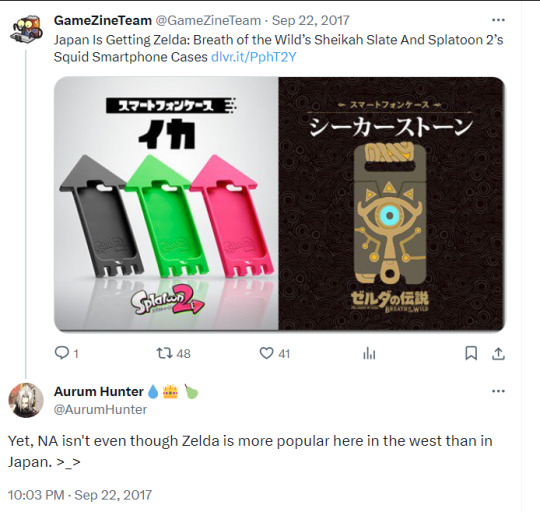


i came across that epic awesome resource from prev post because i was looking around for resources about this subject matter and was listing down whatever sources i could find about it. but since im going to be spending my time reading thru the resource from prev post, i think ill take a break from looking for other sources and just post what ive gathered already! this is what i hv found (under a read more cuz its long 🤭) :
- a newspaper clipping on webarchive published in december 1998 that talks about oot's success in the west (they anticipated to ship 1 million units but are now anticipating to ship 3 million units), and that nintendo had spent $10 million in marketing (idk if its domestic or overseas or overall marketing)
- nintendo's webpage listing the top 10 highest selling titles on their consoles from the nintendo ds and onwards. im pretty sure these are the global figures, not domestic. what's interesting to me is that, with the exception of wind waker hd (wii u title that sold 2.37 million units), there had been no zelda titles that entered the top 10 highest selling titles on a nintendo console, at least not until the nintendo switch w botw + totk. and not on this page at least.. maybe theyd be on the top 10 for previous consoles like the n64 and gamecube 🤔
- youtube video Obscure in the West, Big in Japan by Retrohistories that talks about this study; Making Local video game history index by Akito Inoue!!! now this is super super super super interesting to me. to sum it up super densely, basically researcher Akito Inoue goes thru lists in both english and japanese, lists like Metacritic's Top 100 Games and Famitsu's Highest Ranked Games and many many other lists like these, and gives the listed titles a score out of 100. each title gets two scores, one for it's 'popularity' (possibly not the right term) in the west, and one for it's 'popularity' in japan. bla bla bla many statistical contingencies and whatnot, the video and this study explains this much better than i ever could, but essentially this info can be plotted on a graph, where the higher on the y axis = more acclaimed in the west, and the higher x axis = more acclaimed in japan. and this is what the zelda titles look like!
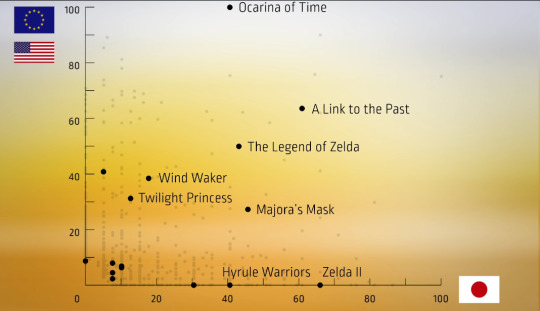
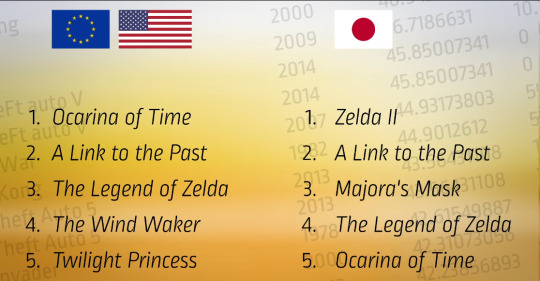
the 'most acclaimed titles' in the west vs japan are so different!!! thats so interesting!!! also this study was last updated in 2018 so thats something to consider. but its like wow.... why is it so different???
also not zelda related but IDC, but this is what final fantasy titles look on this graph!
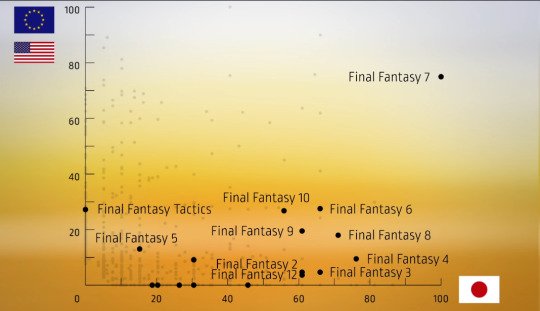
its so interesting....!! what could be the reason for these disparities!!!! why does the west hate my boy squall!!!
- this site that lists down lifetime sales of various zelda titles, published in july 2023 and if im not misunderstanding, was published by J. Clement!
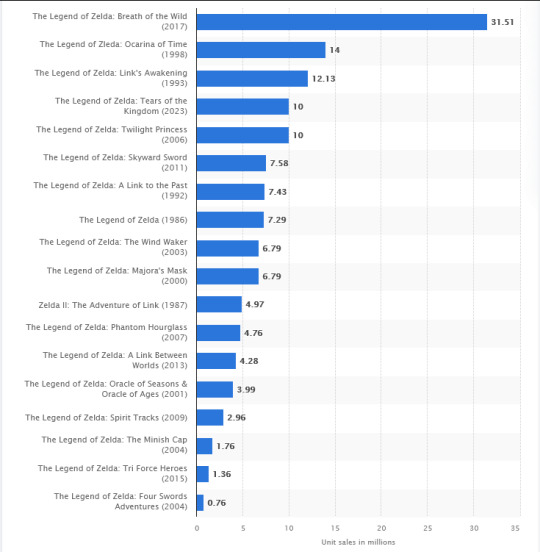
- and lastly, a bunch of resources from Ishaan Sahdev, who wrote The Legend of Zelda - A Complete Development History which i posted about in prev!! the resources are as followed:
- Breath of the Wild is the Highest Selling Zelda in Japan in 19 Years on the resetera forums, with this nifty graph made from info from Media Create, a japanese company that gathers and analyzes video game data:
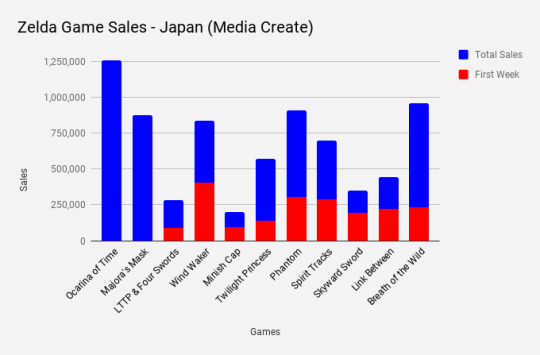
- and this article, Zelda: Breath of the Wild is Beating All Expectations in Japan on Sahdev's website which uses this same graph, and talks about botw's domestic success in more detail (havent completely read this yet)
- two other posts on the resetera forums also by Sahdev, which have these useful figures:
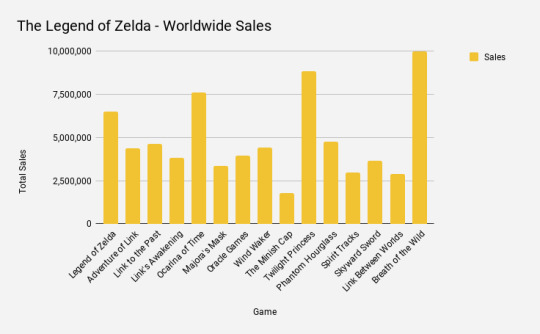
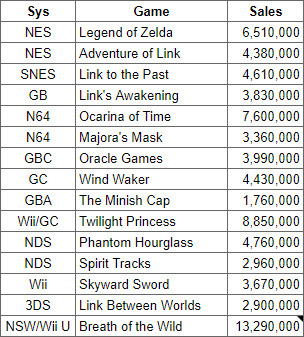
- The Legend of Zelda - Series Sales page on the zelda wiki, which is maintained by Sahdev! (would you look at that, there are actual decent pages on this wiki!)
- and of course, The Legend of Zelda - A Complete Development History, which i believe will go into more depth on how Sahdev acquired these figures, which im very excited to read about!! this dude rocks!!!!
4 notes
·
View notes